
BLOG: APPLIED RESEARCH OF EMMANUEL GOSPEL CENTER
Four Ways Churches Use Their Space for Economic Empowerment
Some churches have successfully transformed their properties into dynamic community centers offering various services, from food pantries and after-school programs to cultural events and neighborhood meetings.
Four Ways Churches Use Their Space for Economic Empowerment
by Saranya Sathananthan, Researcher in Residence
In light of the city's needs, there are unique opportunities for churches to partner with civic leaders, developers, nonprofits, and other stakeholders to further Boston's economic empowerment and vitality. Churches can leverage the underutilized spaces in their buildings for use as commercial kitchens, early childhood education such as daycare centers and schools, affordable housing, and spaces for the arts.
Beyond the economic impact, churches also have the potential to serve as vibrant community hubs and cultural centers, addressing a wide range of local needs. This opportunity allows churches to expand their role beyond spiritual nourishment to include social, educational, and cultural engagement. Some churches have successfully transformed their properties into dynamic community centers offering various services, from food pantries and after-school programs to cultural events and neighborhood meetings.
1. Commercial Kitchens
Many churches have large kitchens with various appliances and accessories that remain underutilized for most of the week. Occasionally, congregation members use these spaces to prepare food for church events or partner with nonprofits to cook meals for distribution or soup kitchens. However, many of these kitchens are not licensed, limiting their use. Imagine the significant economic impact of investing in transforming these kitchens into licensed commercial kitchens.
Food served at public events must be prepared by businesses operating out of licensed kitchens, with the appropriate permits for food handling. Boston has a limited number of shared commercial kitchens where caterers can legally cook for events. Churches offering these spaces to community members would provide crucial support to small businesses needing such facilities throughout the city.
However, running a licensed shared kitchen involves navigating considerable regulatory red tape. Therefore, churches would need to partner with individuals or businesses experienced in this area and develop a partnership where the business operates out of the church space. This collaboration could unlock new opportunities for both the church and the community, contributing to local economic growth.
Fig. 1 A commissary kitchen operating out of First Baptist Church Jamaica Plain.
Fig. 2 A commissary kitchen operating out of First Baptist Church Jamaica Plain.
2. Early Childhood Education (Daycares and Schools)
The cost of childcare in major cities like Boston is staggering. The average weekly daycare cost in 2023 was $321, up 13% from $284 in 2022, which can amount to over $1,500 per month1—if you're fortunate enough to find it that low here in the city. Families often have to tap into savings and rely on both household incomes to cover these expenses. Parents face difficult decisions about whether it's even worth it for both to return to work, as much of their income goes directly to childcare costs.2 The issue is compounded by the limited supply of childcare options, leading to lengthy waitlists, sometimes extending for a year before the child is even born.
In the United Kingdom, many churches have stepped in to provide childcare services, offering much-needed support to families.3 For churches in Boston, creating affordable daycare or a private preschool could be a meaningful social enterprise, especially if there are individuals within the congregation who have the knowledge and passion for running such an initiative. Alternatively, churches might consider partnering with individuals or organizations interested in starting their own school or daycare, provided they share similar values—even if the focus is not on Christian education.
There are, of course, regulatory restrictions to consider, such as compliance with building codes. However, by working closely with a school or daycare partner, churches can either collaborate to make the necessary changes or include those requirements as part of the agreement, ensuring that the partner is responsible for compliance. While some churches may have dedicated spaces for a school or daycare, utilizing shared or multi-use spaces is becoming more common—especially in urban settings. What works best will depend on the needs of both the church and the childcare provider, and it will likely require some compromise to find a solution that benefits everyone involved.
Fig. 3 Entryway to a sanctuary that is used as a preschool during the day at First Baptist Church of Jamaica Plain.
Fig. 4 Entryway to a sanctuary that is used as a preschool during the day at First Baptist Church of Jamaica Plain.
3. Affordable Housing
The 2023 Greater Boston Housing Report Card, produced by the Boston Foundation, highlights a growing crisis. An increasing number of residents across all income and education levels are leaving the region due to skyrocketing housing costs for rentals and homeownership. The existing housing supply does not meet the demand. And Massachusetts lags behind other states in producing more housing—particularly housing that is affordable to middle- and low-income individuals and families.
The Metro Mayors Coalition, which comprises 15 municipalities in Massachusetts, has set a goal to produce 185,000 new housing units between 2015 and 2030 to address this imbalance. However, Boston remains one of the most expensive rental markets in the nation, and the disparities across racial lines are significant according to the housing report card: “Black and Latino families are still far less likely than White or Asian families to own homes in Greater Boston.”4 The report also examined affordability, defining a household as "cost burdened" if it spends more than 30% of its income on housing. The findings were stark: “The majority of renter households in Greater Boston earning less than $75,000 are cost burdened. Overall, about half of renters and a quarter of homeowners in the region are cost burdened.”5
Imagine if churches could help address this issue by creating affordable housing for renters and homeowners in Boston, particularly for those most vulnerable to being financially pushed out of the city. The income saved by residents through church-created affordable housing could significantly contribute to the city’s economic vitality in numerous other ways. For churches open to exploring this non-traditional option, partnering with developers to create affordable housing on their properties is a viable path. Some churches in Greater Boston, such as East Coast International Church in Lynn, Massachusetts, and St. Katharine Drexel Parish in Roxbury, Massachusetts, are already doing this. While it's not easy—requiring access to various city, state, and federal incentives and working with mission-oriented developers rather than purely profit-driven ones—it can make a substantial impact.
For churches where working with developers and funding agencies feels too complex or misaligned with their values, there are other ways to provide affordable housing. Several churches in Boston still own other properties, such as parish houses, which were traditionally used to offer free or low-cost housing for clergy and their families. Many are considering using these parish houses or other properties to provide housing for vulnerable groups. For instance, Restoration City Church in Roxbury, Massachusetts, operates Jasmine’s House, which offers a haven for women rebuilding their lives after being trafficked. Other churches use parish houses as temporary housing for migrants and refugees. There are numerous possibilities.
Moreover, many parachurch ministries actively seek housing for the different groups they serve. This situation presents an excellent partnership opportunity for churches to make their housing assets available for ministry purposes, further extending their impact on the community.
4. Spaces for the Arts
Many major cities are committed to funding the arts. In Boston, significant investments have been made to ensure an equitable recovery for the arts and culture sector following the coronavirus pandemic, supporting everything from theater and dance to public art and libraries. In fiscal year 2023, the City of Boston allocated $25 million in American Rescue Plan Act (ARPA) funding to bolster arts and cultural activities in downtown Boston and neighborhoods across the city as part of their community revitalization efforts. While ARPA funding has concluded, opportunities for the arts continue to thrive.6
Imagine artists using church spaces as studios, galleries, rehearsal spaces, and performance venues. Church communities sometimes undervalue artists, yet they contribute immensely to the cultural vitality of our neighborhoods.
See "Christian Creatives and the Church"
There are numerous opportunities for churches to collaborate with local artists and even co-apply for funding to support public art initiatives. By utilizing non-traditional spaces, such as church properties, for artistic endeavors, churches can create vibrant cultural hubs that benefit and positively impact the community.
Fig. 5 Performance of Benjamin Brittain's "The Prodigal Son" by Enigma Chamber Opera in February 2024 in the Cathedral Church of St. Paul’s sanctuary in Boston. According to the church, part of its strategic plan is to “strengthen the civic fabric by hosting events at the intersection of arts, education, and faith that bring together a wide range of people and address relevant issues of our time.” Photo credit: Rev. Amy McCreath
Fig. 6 The future location of The Center for Faith, Art, and Justice at First Baptist Church of Jamaica Plain in Boston. This space was destroyed by a fire in 2005, and efforts are underway to fundraise to complete its restoration.
Fig. 7 The renovated sanctuary will feature a gallery space. Rendered images courtesy of First Baptist Church of Jamaica Plain.
Fig. 8 The renovated sanctuary will feature a gallery space. Rendered images courtesy of First Baptist Church of Jamaica Plain.
By leveraging their properties in these strategic ways, churches can play a vital role in the economic vitality of their neighborhoods. When cities invest in church spaces, it creates a win-win situation, enabling churches to continue their presence and contributions to the community.
These are only a few opportunities I see having potential for impact. But it’s important to note that the first step before launching into any of these paths is for church leaders to begin these conversations with community stakeholders and city leaders to discern where there is momentum for collaboration and building something new together. It may take years before anything visible is accomplished, yet those relationships built from the onset are foundational for long-term success.
- Care.com Editorial Staff, “This is What Child Care Costs in 2024,” 2024 Cost of Care Report, CARE, Jan. 17, 2024, https://www.care.com/c/how-much-does-child-care-cost/.↩︎
- Kristi Palma, “Child Care Expenses are Crippling, Say Boston.com Readers,” Boston.com, March 2, 2023, https://www.boston.com/community/readers-say/child-care-expenses-are-crippling-say-boston-com-readers/.↩︎
- Hope Together, “Talking Toddlers,” (Research Report), 2020, accessed October 3, 2024, https://www.hopetogether.org.uk/Publisher/File.aspx?ID=257900.↩︎
- Sonia Gupta and Sandy Kendall, eds., “The Greater Boston Housing Report Card 2023 with a Special Analysis of Community Land Trusts,” The Boston Foundation, 2023, 32, accessed October 3, 2024, https://www.tbf.org/news-and-insights/reports/2023/november/2023-greater-boston-housing-report-card.↩︎
- Gupta and Kendall, “The Greater Boston Housing Report Card 2023,” 40, https://www.tbf.org/news-and-insights/reports/2023/november/2023-greater-boston-housing-report-card.↩︎
- “Strengthening Arts and Culture,” City of Boston: Mayor’s Office of Arts and Culture. July 1, 2022, https://www.boston.gov/departments/budget/strengthening-arts-and-culture.↩︎
What happens when church buildings close?
Churches faced with aging buildings, lack of parking, and aging, dispersed membership may find selling their buildings necessary—or even advantageous. What happens to the buildings when they do?
Trends and status of Christian institutional property ownership in the City of Boston
by Rudy Mitchell, Senior Researcher
Boston is home to about 575 Christian churches. While many of these rent space from other churches, organizations, or private owners, a significant number of congregations own and meet in traditional church buildings, former commercial properties, or converted residential buildings.
Currently, churches and their denominations own about 320 properties in Boston, including 256 buildings primarily used for worship, ministry, and service.
In recent decades, some church-owned buildings have been sold to other congregations, developers, and private business owners. As a result, about 45 buildings formerly owned by churches or religious organizations have been lost to the Christian community as well as the communities and neighborhoods these churches once served and called home.
These churches not only contributed to the spiritual well-being of their neighborhoods but also played an important role in sustaining the social fabric of their communities. Many provided a variety of social services and enriched civic life. Memories of important life events were tied to these sacred spaces.
As a result, the loss of these congregations and sacred spaces has had a deeper impact than is often realized.
In a constantly changing city and culture, there are many reasons why congregations decline, and church buildings are sold. To stay vital to the life of the community, churches require spiritual renewal and the ability to adapt to younger generations. Shifting demographics also can affect congregations, particularly when their members move to different areas farther from the church building.
In the Boston area, this movement of people is influenced by ever-rising housing costs and, in some neighborhoods, gentrification: the process of higher-earning and more educated residents moving into historically marginalized neighborhoods. While gentrification brings increased financial investment and renovation to a neighborhood, it often also leads to a rise in housing costs, which results in the displacement of long-time residents. This dynamic disrupts congregations, as church members may be displaced or move elsewhere. Churches faced with aging buildings, lack of parking, and aging, dispersed membership may find selling their buildings necessary—or even advantageous. Sometimes, congregations that were renting space are no longer able to afford the cost.
What happened to these buildings?
Congregations, which own and meet in residential houses, often adapted the first-floor space for worship. In several cases, when sold, the new owner has changed the occupancy, converting the space into a residence and adding an additional unit.
Iglesia de Dios Pentecostal at 68 Day St. in Jamaica Plain used the first floor for church services, but after the building was sold, the first floor was changed into a residential unit.
The Greater Community Baptist Church at 27 Howland St. in Roxbury used to meet in a converted house with a brick addition on the front. When this property was sold, the new owner removed the addition and converted the building to a two-family house.
Iglesia de Dios de la Profecia owned a tax-exempt converted house at 20 Moreland St. in Roxbury, which was sold and converted into a private two-family residence.
On Melville Avenue in Dorchester, the Salvation Army used a large house and 35,000-square-foot lot as a ministry center and church called Jubilee Christian Fellowship. When sold in 2022, the property was turned into a two-family luxury residential building.
While several houses used as church buildings have been sold, congregations such as the Church of God and Saints of Christ on Crawford Street and Spirit and Life Bible Church on Columbia Road continue to meet in converted houses.
In the past, numerous churches met in commercial or storefront properties, even in neighborhoods like the city's South End. Some storefront churches rented space, while others purchased the buildings when prices were relatively low. As rental prices rose and neighborhoods gentrified, several churches renting storefronts had to move out or close.
One rental storefront church space became a dental office, and another became a restaurant. Several church spaces have become laundromats. For example, the Full Life Gospel Center in Codman Square decided to sell its storefront property and buy another Dorchester church building whose Haitian congregation had moved to a former synagogue in Randolph. The former Full Life Gospel Center property on Washington Street was then renovated into a laundromat.
“Over the last 50 years in Boston, as the city has changed and property has become much more expensive, many former storefront churches have disappeared.”
Although churches, which own commercial-type space, generally have not needed to move, some have chosen to sell and relocate or buy other buildings. Grace Church of All Nations in Dorchester chose to sell its storefront property to a CVS Pharmacy and purchased a former Christian Science Church in Roxbury. Over the last 50 years in Boston, as the city has changed and property has become increasingly expensive, many former storefront churches have disappeared.
From the 1950s to 1970s, as neighborhood churches in Boston declined and congregations were leaving the city, many church buildings and synagogues were sold or passed on to new Black, Haitian, or Hispanic congregations. In recent years, some church buildings have been sold to other congregations, while many others have been lost to the religious community altogether.
Some churches with valuable properties may have concluded their assets could be better spent on more extensive, less expensive, and more modern facilities in other areas, closer to where their congregants live. Those congregants who used to live in Lower Roxbury, Roxbury, or Dorchester may now live outside the city because of escalating housing costs in Boston. Although some churches that have sold city buildings have rented temporarily, most have purchased other buildings.
The 45 church buildings cited earlier represent over 30 congregations that have closed permanently. Others have either moved elsewhere in the city—such as Grace Church of All Nations, New Hope Baptist Church, Full Life Gospel Center, Mount Calvary Baptist Church, Church of God of Prophecy, Boston Chinese Evangelical Church—or moved out of the city—such as Trinity Latvian, Christ the Rock Metro, Concord Baptist Church, and Ebenezer Baptist. Some congregations, such as Holy Mount Zion Church, New Fellowship Baptist/Spirit and Truth, and Mount Calvary Holy Church, are left in limbo due to fires, structural deterioration, or financial constraints.
Although some churches have relocated outside the city of Boston, the overall number is still relatively small compared to the total number of churches currently in the city. As lower- and middle-income Boston residents, as well as new immigrants, settle in communities farther from downtown, new churches are also starting up in these communities. At the same time, inner-city churches are losing members who no longer commute back to their former congregations.
When traditional church properties are sold to non-church buyers, they are mostly converted into market-rate residential units, such as condos or apartments. However, there are notable exceptions to this: St. James African Orthodox Church in Roxbury, Hill Memorial Baptist Church in Allston-Brighton, and Boston Chinese Evangelical Church in Chinatown.
St. James African Orthodox was rescued from demolition and private development through neighborhood activism and the help of Historic Boston, Inc., which purchased the building, made repairs, and eventually resold it to a community organization, the Roxbury Action Program. (In the process, Historic Boston, Inc. tried to interest other churches and community organizations in developing the building cooperatively; however, no churches could take on the project.)
Hill Memorial Baptist worked with a neighborhood development organization and the City of Boston to see their church sale result in plans for affordable senior housing, with the church building preserved to serve as a social center for the new residents. The church, its denomination, and the Allston Brighton Community Development Corporation went through a five-year partnership and planning process to achieve positive outcomes for the community and church.
Boston Chinese Evangelical is another unique example of a traditional church-building sale. Over the years, church leaders were in dialogue with the City of Boston and the Boston Public Schools about their church building and property in Chinatown, which was in a strategic location next to the Quincy Elementary School. After the congregation purchased a large, nearby building at 120 Shawmut Ave., it sold its church building to the city. The church building was demolished, and the new Josiah Quincy Upper School was built on the site.
While the St. James African Orthodox and Hill Memorial Baptist congregations closed, the Boston Chinese Evangelical congregation continues to use a diverse portfolio of property that includes rented worship space at the Josiah Quincy Elementary School, its multi-purpose building at 120 Shawmut Ave., and a Newton, Massachusetts, satellite church building.
Preserving and sustaining church congregations and their properties is critical for the health of Boston’s neighborhoods. Churches’ physical and spiritual presence contributes to their communities on many levels.
Congregations that want to stay in their current neighborhoods can seek ways to serve others and sustain themselves by renting space to community groups or other congregations. Churches looking to close or relocate and sell can plan and consider positive outcomes for their building by selling to another church or community-serving organization. They can also work to see community development efforts, such as community centers or affordable housing units, built within the church or on its site.
Why isn’t my church talking about race?
Many white Christians in evangelical churches feel isolated in their desire to discuss race, often encountering silence or pushback from their communities. Engaging with racial issues from a biblical perspective is essential for fostering unity and effectively following Jesus in a diverse world.
Photo credit: Shaun Menary via Lightstock
Many white Christians in evangelical churches feel alone in their desire to talk about race
by Megan Lietz, Founding Director, Race & Christian Community Initiative
It came from the look in the pastor’s eyes, the awkward pauses in the conversation, the tone that, while appropriate to the passing ear, couldn’t help but feel patronizing. Here I was again, having my faith held suspect because I believe Jesus calls Christians to engage in issues related to race.
At that moment, I knew I had about 30 seconds to establish I was “one of them.” To assert my faith and prove I really am a Bible-believing Christian. There was no time to share that I was born and raised in white evangelicalism, with my teenage years defined by youth conferences and summer missions trips, WWJD bracelets and promise rings. There was no time to mention I believe the Bible is the Word of God and that I learned to study it at evangelical colleges and seminaries. No time to talk about how much my faith means to me, what it has brought me through, or my deep love for Jesus.
It was as if none of that mattered. Certainly, none of it was seen. All it took was the word “race,” and I was written off as a “liberal.”
It was all right. It was a brief interaction with a pastor I had never met before and would probably never see again. Yet it represented a painful reality I often hear about from white brothers and sisters in theologically conservative churches.
“It was as if none of that mattered. Certainly, none of it was seen. All it took was the word ‘race,’ and I was written off as a ‘liberal.’”
One brother shared he feels the discipleship he received did not prepare him to engage our multiracial reality. Another sister said she had to leave her beloved church community after many years because she no longer feels at home in an environment that regards race as a side issue.
The challenges white folks encounter when exploring issues related to race don’t compare to the pain and oppression experienced by people of color. Yet, it is essential for white people to learn how to navigate the obstacles we encounter so we can be better positioned to experience and contribute to racial healing.
Many white brothers and sisters who participate in the Race & Christian Community Initiative (RCCI) often express how refreshing it is to be able to talk about race in the context of Christian community. Sadly, even though these issues are coming up in conversations around the water cooler and blowing up their news feeds, they’re not able to discuss race in their congregations. It’s not mentioned from the pulpit, explored in Bible studies, and certainly not a topic for casual conversation.
Even if it is explored at those lamentable moments when racial violence captures our collective attention, the conversation’s life cycle often mirrors that of the news cycle: a one-off here, a one-off there — reactive events choked out by donor pushback and competing priorities.
When churches don’t talk about race, white folks who care about the issue can often feel isolated at best. Well-meaning comments about “slippery slopes” and how “race is a distraction to the gospel” can make us feel frustrated, suspect, or unwelcome. It can even lead to a crisis of faith as we start to believe the lie that the Living Word does not speak into the realities of racial injustice.
Engaging issues related to race from a biblical perspective does not cause us to lose our faith. It helps us follow Jesus more faithfully.
White evangelicals’ disengagement from race has little to do with Scripture. On the contrary, the Scriptures we highly esteem speak abundantly into the issues of unity, diversity, ethnicity, culture, power, oppression, healing, and justice. Our disengagement can be explained — not by God’s heart — but by the result of social and historical realities.
For example, as members of the dominant culture in the U.S., we often don’t have to think about race. Our social location can make us oblivious to the realities of racism.
“The Scriptures we highly esteem speak abundantly into the issues of unity, diversity, ethnicity, culture, power, oppression, healing, and justice.”
Closely related to this, white folks tend not to explore race in our theology. This dynamic is especially problematic when most Christian educational institutions center Euro-American theology as normative and comprehensive. It has left many Christians less aware of God's heart for justice and how the interconnected body has experienced the God of justice in their lives.
The fundamentalist-modernist controversy of the 1920s and ’30s led theologically conservative Christians to largely disengage from social issues so they might distinguish themselves from more theologically liberal expressions of the faith. The impact of valuing orthodoxy over faithfully living into Jesus’ heart for justice continues today.
Because of realities like these, white evangelicals lack the experience, theological frameworks, thought leadership, and examples from within our traditions to build shalom across racial lines. While this can make starting the conversation even more intimidating, we cannot afford to stay silent. When we don’t address issues of race, we do damage to the kingdom of God.
Whether white evangelicals acknowledge the problem or not, we are complicit in the ways racism harms our brothers and sisters of color, diminishes ourselves, and dishonors the image of God. When white congregations don't talk about race, there are significant consequences:
Disunity: Christian communities remain segregated. While being in a racially homogenous congregation is not bad within itself, it becomes a problem if white congregations are homogenous because people of color do not feel welcome, included, or cared for. This can often be the case if congregations are not talking about race, culture, or power dynamics that many people of color experience as a regular part of life.
Church hurt: We lack the discipleship needed to build shalom across racial lines, allowing the perpetuation of racial brokenness in and through Christian communities.
Diminished witness: The harm done and the deeply-seated division in the Church diminish Christian witness. When we know the Great Physician but aren’t working toward racial healing, we miss out on opportunities to demonstrate God’s power and presence.
Waning influence: When the Church isn’t even speaking into a sorely felt need in our society, we shouldn’t be surprised when people stop listening. Instead of proclaiming that Jesus is good news in the midst of racial brokenness, too many white Christians have remained silent and are allowing secular organizations to lead the way.
“We cannot afford to stay silent. When we don’t address issues of race, we do damage to the kingdom of God.”
It doesn’t have to be this way. The Bible offers principles, parallels, and language white Christians can use to talk about race. We can also learn from the traditions of Black, Indigenous and people of color, who have rich legacies of addressing racism. There are also numerous resources by evangelical publishers and denominations on how our faith connects to race.
There are paths ahead. But too often, fear, competing priorities, and well-trodden pathways get in the way.
RCCI creates spaces where white Christians can talk about race. Be it learning communities for white evangelicals, conversations over coffee, or opportunities to reflect on and learn from serving across racial lines, we desire to create a place where white folks can learn and grow in Christian community. We also come alongside predominantly white congregations, meet them where they are, and help them take the next step in exploring issues related to race from a biblical perspective.
The richness of RCCI comes not because we get it all right, but because we create spaces for people to have conversations the Lord is already stirring within them. With love and grace, we create opportunities for the Lord to continue the work he desires to do. And as we invite him in, we see healing, we see hope, we see perspective transformation. What excites us most is seeing people move from talk to action, bearing witness to the person and power of Jesus by continuing his redemptive work across racial lines.
Will you join us in talking about race? Will you learn with us as we explore the conversation? We don’t always say the right thing, but we long to know the Lord more fully, serve him more faithfully, and usher in his kingdom by how we engage across racial lines.
Christian Organizations Addressing Social Issues
This guide showcases organizations addressing some of the most pressing social issues. Their endeavors range from supporting vulnerable children and families to promoting environmental stewardship.
Photo credit: Matt Vasquez via Lightstock
by Rudy Mitchell, Senior Researcher
Boston is home to an array of initiatives dedicated to tackling social issues. Many churches and Christian organizations are at the forefront of addressing these needs. Some have been serving for decades. Others are new.
This guide showcases Christian organizations addressing some of the most pressing social issues. Their endeavors range from supporting vulnerable children and families to promoting environmental stewardship.
Organized into over a dozen categories, this guide lists many organizations engaged in this work. Whether you want to collaborate, network, volunteer, or learn more about what God is doing in our city, we hope this guide serves as a valuable resource.
This is not meant to be a comprehensive list. Don’t see a Christian organization you think should be included? Feel free to contact us to suggest any additions.
-
“The mission is to engage and equip neighbors, volunteers, and congregations to build strong communities characterized by God’s shalom.
“Shalom means wholeness, peace, well-being, righteousness, and justice.”
The ministry applies “community-building strategies that include strengthening youth and families, developing leaders, multiplying collaborations, and investing in corner-by-corner transformation resulting in a more green, healthy, safe, connected, and economically-empowered neighborhood.”
For more on their youth programs, see "Youth" below.
Website: tbpm.org
Email: tbpm.org/contact
Phone: (617) 929-0925
Location: 15 Elmhurst St., Dorchester, MA 02124
Cory Johnson Program for Post Traumatic Healing
“The Cory Johnson Program for Post Traumatic Healing is a Christ-inspired, community-based, clinically-supported 501c3 program of the Roxbury Presbyterian Church Social Impact Center that offers a peer-centered approach to addressing post-traumatic stress in urban neighborhoods.” The program fosters connections and empowers individuals to take active roles in helping themselves and others heal. The main outreach of the Cory Johnson Program is the Can We Talk Network, which has several sites in Boston.
Can We Talk Roxbury: “This program component offers a safe, sacred space for people to share their stories of trauma, loss, grief, and hope in words, poetry, or song. Artists in residence offer their creative expressions, and Community Companions offer support. It is a place for listening, and people experience individual and community healing.” Other support groups are also available.
Contact: Danielle McFarlane, dmcfarlane@rpcsic.org
Location: Roxbury Presbyterian Church, 328 Warren St., Boston, MA 02119
Codman Square Can We Talk? A partnership with the Boston Project Ministries, Life Church Boston, Second Church of Dorchester, and Neighborhood Church of Dorchester. “Codman Square Can We Talk? is a safe place to share your story and have your voice heard and welcomed. It is a community-based, clinically-supported program that increases awareness and understanding of trauma, offers mental health resources, and a safe environment for what can at times be painful conversations to occur.”
Phone: Contact through The Boston Project by dialing 617-929-0925 or emailing Maridena Rojas, maridena@tbpm.org
Location: Community Room, 86 Southern Ave., Dorchester
Also: Anointed Fire Church, 777 Washington St., Dorchester; Contact: Tony Fernandes, tonya_f@hotmail.com
Peace by Piece: Fourth Presbyterian Church
Contact: Lauren Basler, laurenabasler@gmail.com
Contact: Rev. Burns Stanfield, bstanfield@hds.harvard.edu
Location: 340 Dorchester St., South Boston, MA 02127 and 5 O’Connor Way, South Boston, MA 02127
Emmanuel Episcopal Church of Boston (Common Cathedral)
Contact: Rev. Carrington Moore, carrington@commoncathedral.org
Location: 15 Newbury St., Boston, MA 02116
Boston Trauma Healing Collaborative
“The vision of Boston Trauma Healing Collaborative is to develop an integrated strategy that draws from the strengths of current trauma healing programs (both locally and nationally), to train and equip churches and communities to become more trauma-informed as they respond to wounded people and unacceptable realities that are often rooted in trauma. . . .
“This integrated strategy includes a collaborative effort between BTHC, as a local partner with the American Bible Society and the Trauma Healing Institute, and the Cory Johnson Program for Post-Traumatic Healing and their Can We Talk… Network, which will help encourage churches and non-profit organizations to work together to bring healing to those wounded by trauma.”
Others
American Bible Society Trauma Healing: ministry.americanbible.org/trauma-healing
Trauma Healing Institute: traumahealinginstitute.org
Cory Johnson Program for Post-Traumatic Healing: rpcsocialimpactctr.org
Can We Talk… Network: canwetalknetwork.org
-
“For an individual who has experienced the life-shattering effect of domestic abuse, Hagar’s Sisters is a non-profit organization that offers holistic services that empower them to find healing and a new healthy way of life that is free from abuse.”
Website: hagarssisters.org
-
Boston Education Collaborative
The Boston Education Collaborative (BEC) is an initiative of the Emmanuel Gospel Center which recruits, trains, and connects church volunteers with underserved schools to address disparities in educational opportunities.
The BEC “empowers churches, schools and non-profits to support underserved urban students. BEC helps students thrive in all areas of life by nurturing and supporting church-school partnerships; facilitating and encouraging neighborhood-focused involvement; engaging in systems level work; and participating in broader networking, coaching, and learning opportunities.”
Leadership: Ruth Wong, director
Website: egc.org/education
Email: rwong@egc.org
Phone: (617) 262-4567
Boston Higher Education Resource Center (at Congregación León de Judá)
Mission: “The Boston Higher Education Resource Center (HERC) functions to equip first-generation youth of color to access and thrive in higher education, to break the cycle of poverty, and to become agents of change in our communities.”
The Passport Curriculum is designed to equip 11th and 12th-grade students to navigate the college admissions process and the college world successfully while gaining and developing their academic and leadership skills. The center offers both in-school programs and a community-based program at 62 Northampton St. These programs are far more extensive than typical after-school tutoring programs.
Leadership: Carolina De Jesus, CEO; Junardy Jean-Charles, Passport to College Program Director
Website: bostonherc.org
Email: info@bostonherc.org and infopassport@bostonherc.org
Phone: (617) 221-6495
Location: HERC, 62 Northampton St., Boston, MA 02118
American Chinese Christian Educational & Social Services, Inc. (ACCESS)
Mission: “ACCESS seeks to empower, encourage, & motivate immigrants to build confidence, gain skills, and the ability to make positive changes within their own lives.”
Vision: “We want to see our Chinatown neighbors thriving and building bridges across languages, cultures, and generations in God's love.”
Their programs include K-5th grade enrichment afterschool and summer programs, adult fitness as well as arts and crafts programs in Tai Tung Village.
Leadership: Pasang Drolma, executive director; Annie Tran, director of children and families
Website: chinatownaccess.org
Email: info@chinatownaccess.org
Phone: (617)-426-1070
Location: 244 Harrison Ave., Boston, MA 02111
Victory Generation Programs of the Black Ministerial Alliance/Ten Point, a network of faith-based, out-of-school educational enrichment programs.
Mission: “Our mission is to empower and strengthen out-of-school program leaders and their staff who serve as role models and the front-line to the children and families we wish to serve. In addition to building impactful and qualifiable programs for students, we also provide workshops and training to empower parents in advocating for their children and fostering positive school relationships.”
Leadership: Rochelle Jones, director of education
Website: bmatenpoint.org/victory-generation
Email: info@bmaboston.org
Phone: (617) 445-2737
“Victory Generation directly aids out-of-school programs dedicated to nurturing, strengthening, and enhancing the social, emotional, and cognitive development of Boston's youth aged 5 – 12. As an intermediary, we support our affiliated programs by enhancing their organizational and programmatic capabilities. Our assistance includes networking, financial aid, professional development workshops, and technical guidance.”
Sites
Twelfth Baptist Church After-School
Leadership: Darryl Simpson, program director
Website: tbcboston.org
Email: dsimpson@tbcboston.org
Phone: (617) 427-5158; main line: (617) 442-7855, ext. 121
Location: 160 Warren St., Roxbury, MA 02119
Hours: Monday - Friday, 2-6 p.m.
Greenwood Shalom After School Program (a Victory Generation site)
Greenwood Shalom offers a range of enriching activities designed to engage and inspire students. These include tutoring, homework assistance, interactive online learning using Lexia, art, music, STEM projects, physical fitness, social emotional support, field trips, play, and test prep.
Programs
After-school enrichment program for children ages 5 to 13.
Summer enrichment program
English Language Arts Bootcamp: A full day program in February vacation week.
Math Bootcamp: A full day program during April vacation week.
Saturday Online Academy (10 a.m. - noon): Designed to uplift and empower students who may face barriers to traditional academic and emotional support.
Healing Hearts Club Camp: A transformative five-day program designed to provide healing and support for children ages 8 to 13 who have experienced trauma.
Contact information
Coordinators: Sasha Desrosiers and Jennifer Merren
Website: greenwood-outreach.org
Email: greenwoodshalom@gmail.com
Phone: (617) 282-1464
Location: 378 Washington St., #A, Dorchester, 02124. (The entrance is on Dakota Street.)
Mission: “To promote diversity, equity, and inclusion in education, employment and opportunity through long-term relationships with youth and their families and communities.”
Programs
B Ready
Afterschool enrichment program for students grades 1-12. See ssypboston.org/bready for more details.
B Safe
“Summer enrichment program - provides a safe, fun, academically enriching environment for 650 students each year. We run B-SAFE at our year-round sites in the South End and Lower Roxbury and at four additional sites in Dorchester, Mattapan, and Chelsea.
Intergenerational Organizing
This program “equips young people to become agents of change and helps them to organize their neighbors, parents, and peers to address the issues of that disproportionately impact their communities” (such as gun violence).
Contact information
Leadership: Inés Palmarin, executive director; Eva Ortez, chaplain
Website: ssypboston.org
Email: info@ststephensbos.org
Phone: (617) 262-9070
Sites
South End: St. Stephen’s Church at 419 Shawmut Ave., Boston, MA 02118
Lower Roxbury: The Church of St. Augustine and St. Martin at 31 Lenox St., Boston 02118
-
Massachusetts Interfaith Power & Light
“Mission:
• To educate people on why climate change is a matter of morality and justice.
• To foster public understanding of policies that will lead to a sustainable future.
• To work with faith communities and their members to be better environmental stewards of their buildings by providing technical expertise and assessing ways they can lower their carbon emissions and save money.”
Website: massipl.org
Email: info@MassIPL.org
Phone: 617-244-0755
Address: P. O. Box 600163, Newton, MA 02460
Better Future Project builds grassroots power to advance a rapid transition beyond fossil fuels. Communities Responding to Extreme Weather (CREW), a program of Better Future Project, is Better Future Project's network of local leaders building grassroots climate resilience. In 2023, CREW sponsored the Interfaith Summit, How to Respond to Climate Change.
Rev. Vernon Walker, former director
Location: 30 Bow St., Cambridge, MA 02138
Boston Faith & Justice Network
Boston Faith & Justice Network, as part of one of its online book club discussion series, has focused on how we as Christians are called to climate justice. See the BFJN website for recommended resources and readings.
Leadership: Elizabeth Grady-Harper, executive director
Website: bostonfaithjustice.org/learn
Email: info@bostonfaithjustice.org
-
“Fostering Hope empowers churches and individuals to care for children and families impacted by foster care.
Our vision is the dream of a day when ZERO children in foster care are waiting for a safe and supported family to care for them. This initiative is called Project ZERO. “
Leadership: Jonathan Reid, founder and director
Website: fosteringhope.org
Email: info@fosteringhope.org
Phone: (401) 524-0949
-
Initiative on Health, Religion, and Spirituality
Although this organization is not independent, it addresses the important relationship between spiritual care and spirituality to medical care and physical health. The initiative is centered at Harvard Medical School and the Harvard School of Public Health.
It aims “to study and implement ways to better integrate religion and spirituality into the practice of medicine and public health. It seeks to discover individual and social connections of spirit, mind, and body within the healthcare context. Advancement of spirituality research is energized by the practical concern that new discoveries from spiritual and religious resources will yield significant new gains in alleviating illness and promoting human flourishing.”
Some of the studies are relevant to end-of-life spiritual care.
Faculty leaders include Dr. Tracy Balboni, Dr. Michael Balboni, Ms. Laura Tuach, and Dr. Tyler VanderWeele.
Website: projects.iq.harvard.edu/rshm/home
Email: xavier_symons@hsph.harvard.edu (Xavier Symons, administrator)
Location: 12 Arrow St., Cambridge, MA, 02138
Boston Health Care Fellowship and Longwood Christian Community
“Our vision is to reunite faith and healthcare in line with God's intention of bringing healing to the world. To that end, we exist to make disciples of Jesus among those in the biomedical science and healthcare community in Boston for the glory of God.”
Website: healthcarefellowship.org
Location: Boston Healthcare Fellowship, Longwood Medical Area, Boston, MA 02120
Christian Medical and Dental Society
The Christian Medical and Dental Society “has over 340 healthcare campus ministries as well as over 80 community ministries. Along with encouraging students to live out the character of Christ on their campuses, they help Christian healthcare professionals connect with each other through local ministries.”
Campus chapters
-
Housing Justice
“The Boston Rescue Mission transforms lives by empowering individuals experiencing homelessness or who are at risk of becoming homeless to achieve and sustain life skills necessary to become more self-sufficient.
“We operate an emergency overnight shelter every year. We offer healthy and hearty meals, basic necessities, and bathroom and shower facilities. We provide sober living and life growth shelter communities for men in recovery transitioning from homelessness to independent living.
“Our mission is to
Offer resources that prevent and end homelessness
Support the recovery, health, faith, and independence of those with a history of substance use, incarceration, and homelessness
Raise awareness about the root causes of homelessness, addiction, and incarceration
Serve our guests and residents and each other with respect, integrity, and grace
Continue to learn, grow, and excel in our services
Be good stewards of the resources entrusted to us by our supporters”
Contact information
Website: brm.org
Email: info@brm.org
Phone: (617) 338-9000
Location: 39 Kingston St., Boston, MA 02111
Veterans’ House: 173 Humboldt Ave., Dorchester, MA 02121
Faith Leaders for Housing Justice
“A coalition of Boston area faith leaders collecting and sharing information and stories about issues facing people with housing insecurity.”
The group is involved in several practical ministries. Leaders include Art Davies, Rev. June Cooper, Sara Mitchell, Jennifer McCracken, Amanda Grant Rose, and Phil Jones. They are working in partnership with the Boston Faith & Justice Network.
Website: bostonfaithjustice.org/fl4hj/
Send Relief: Boston Ministry Center's Friendship Initiative
“The Friendship Initiative of the Boston Ministry Center seeks to build friendships with neighbors experiencing homelessness. It begins with sharing a meal, engaging in constructive conversations and transforming lives through fulfilling relationships.”
Leadership: Andrew Montoya, coordinator
Phone: (401) 443-6839
Location: Boston Ministry Center, 88 Tremont St., Boston, MA 02108
MANNA (Many Angels Needed Now and Always)
MANNA is a “ministry of and with the unhoused community in downtown Boston. Through MANNA, we seek not only to welcome folks across differences of class, wealth, culture, race and mental ability, but also to empower all people to claim their place as essential members of our community. We all have gifts to give and to receive. We need each other. And this is why we gather each week to serve, to pray, and to create together.”
Mission statement: “To provide a space for spiritual refuge and flourishing; To build a community of genuine belonging with the unhoused and unstably housed of Boston.”
Leadership: Rev. Jennifer McCracken, contact and lead pastor
Website: mannaboston.org
Email: mannaboston.org/contact
Location: St. Paul’s Cathedral, 138 Tremont St., Boston, MA 02111
Hours of ministries:
Gathering of friends over coffee and worship service (Sundays, 8:30 - 11 a.m.)
Lunch and worship service (Mondays, 9:30 a.m. - 2 p.m.)
Black Seed Writers Group (Tuesdays, 9:30 - 10:45 a.m.)
Quiet Meditation (Tuesdays, 11 a.m. - noon)
"Miracle Mile Ministries is a Boston, MA based Christian ministry devoted to a sustained, deliberate, and strategic response to the area we call ‘Miracle Mile’ (a roughly 2-square-mile area in the South End of Boston often referred to as ‘Mass & Cass’ or ‘Methadone Mile’).
“It is led by a core group of four Boston area Lead Churches (Congregación León de Judá, Antioch Community Church Brighton, Cornerstone Church, and Symphony Church) but involves a universe of a dozen or so churches and parachurch ministries from throughout Boston's neighboring communities who faithfully support this effort week after week.”
Saturday ministries include breakfast, prayer, clothing distribution, counseling and referral, and street outreach.
Website: miraclemileministries.com
Email: cljstreetministry@gmail.com
Saturdays at 9 a.m. (volunteers arrive at 8 a.m.)
Location: Congregación León de Judá, 62 Northampton St., Boston, MA 02119
Winter Walk is a non-profit organization raising awareness and funds to end homelessness in our communities. It centers on an annual walk, 2 miles around the streets of the city in February, one of the coldest months of the year. The Winter Walk raises awareness and funds for 25 non-profit organizations working to alleviate suffering and address the root causes that give rise to homelessness. It helps fund St. Francis House, Common Cathedral, and the Manna Community. Also, various church groups have participated in Winter Walk.
Website: winterwalk.org
Email: info@winterwalk.org
Although not specifically a Christian organization, Women’s Lunch Place operates at the Church of the Covenant at 67 Newbury St. in Boston.
Leadership: Jennifer Hanlon Wigon, executive director
Website: womenslunchplace.org
Email: info@womenslunchplace.org
Phone: 617-267-1722
Affordable Housing
Greater Boston Interfaith Organization
“The Greater Boston Interfaith Organization (GBIO), founded in 1998, is a broad-based organization that works for the public good by coalescing, training, and organizing people across religious, racial, ethnic, class, and neighborhood lines.” “Our mission is to build power by developing local leaders so we can act together on issues that matter to our communities.”
Housing Justice Campaign
“This comprehensive, multi-pronged, statewide Housing Justice campaign addresses challenges to safe and dignified public housing, affordable rental and homeownership, and access to supportive housing for citizens returning housing justice and other issues.”
Leadership: Allie Gardner, chief of staff, (608) 630-3041; Kathleen Patron, executive director
Website: gbio.org
Email: office@gbio.org
Mailing address: GBIO, P.O. Box 190892, Roxbury, MA 02119
Location: GBIO, 1803 Dorchester Ave., Dorchester, MA 02124
“Habitat for Humanity Greater Boston’s homeownership program provides homeownership opportunities to families without the financial means to purchase a home through traditional methods. By utilizing volunteer labor, sweat equity, and donated supplies and funds, Habitat Greater Boston can build and sell homes at an affordable price to first-time homebuyers.” Since its founding, the organization has used its model to build more than 120 homes in Dorchester, Roxbury, and other neighborhoods.
Website: habitatboston.org
Phone: 617-423-2223
Location: 434 Massachusetts Ave., Suite 201, Boston, MA 02118
-
Mission: “Amirah exists to provide a refuge for those seeking to break free from exploitation and heal in community on their journey toward lasting hope. “ “Amirah exists to provide exit and aftercare opportunities to women exiting the commercial sex trade.”
Amirah’s “supportive services include comprehensive case management, economic stability planning, housing navigation, support groups, individual coaching, and peer care navigation. We provide supportive services to clients living in our residential program, those housed in other local housing programs, and clients housed independently or seeking housing placement.”
Amirah also has a rapid rehousing program, a community resource center, and education programs.
Leadership: Mary Speta, executive director
Website: amirahinc.org
Email: info@amirahinc.org
Phone: (781)-462-1758
Location: 100 Cummings Ctr, Suite 204-J, Beverly, MA 01915 (office)
“The mission of Route One Ministry is to serve sexually exploited and trafficked women by entering strip clubs and building relationships with the women who work in the clubs. We also strive to equip the local church, and community leaders with the tools they need to understand trafficking, identify vulnerable people, and respond in the most healthy ways to those who have experienced sexual abuse.”
Leadership: Bonnie Gatchell, executive director
Website: lovedbyrouteone.org
Email: info@lovedbyrouteone.org
Send Relief: Boston Ministry Center’s Beloved Initiative
“The Beloved Initiative is an effort to serve human trafficking and sexual abuse survivors as they are brought into safe community with opportunities to be mentored and empowered to embrace new identities in Christ.” This ministry is a part of the Boston Ministry Center.
Leadership: John Ames, director
Phone: (401) 443-6839
Location: Boston Ministry Center, 88 Tremont St., Boston, MA 02108
-
“Harbor Christian Counseling provides clinically skilled, biblically informed, gospel driven counseling services for individuals, couples, children and families in the Greater Boston area. Our team also seeks to partner with local churches to provide training and resources that promote a more effective and compassionate ministry to mental health issues within the church.”
Leadership: Matt Warren, executive director
Website: harborchristiancounseling.com
Phone: (617) 299-6516
Location: 874 Beacon St., Boston, MA 02215
-
Boston Faith & Justice Network
"The Boston Faith & Justice Network brings Christians from many traditions together to move from personal religious commitment to transformative action against poverty and oppression. We foster a dialogue about money and responsibility while presenting opportunities for practical lifestyle shifts and justice-oriented engagement. Economic discipleship—following Jesus with our money—is one of the foundations of our vision for Christ-centered just living."
Leadership: Elizabeth Grady-Harper, executive director
Website: bostonfaithjustice.org
Email: info@bostonfaithjustice.org
Massachusetts Poor People's Campaign
The Poor People's Campaign, a national ecumenical and interfaith anti-poverty campaign, seeks to confront the interlocking injustices of systemic racism, poverty, ecological devastation, the denial of health care, militarism and the expansion of the war economy, and the false narratives of religious extremism and white supremacy. Cynthia Parker is one of the local Massachusetts organizers.
-
Emmanuel Gospel Center (EGC): The Race & Christian Community Initiative (RCCI)
RCCI collaborates across racial lines to foster shalom between individuals, communities, and systems damaged by racism. “RCCI works toward this vision by equipping Christians in Greater Boston to engage issues of race in ways that honor the image of God in all people and nurture the righteousness and justice Jesus desires for our communities.”
RCCI “provide[s] biblically-based discipleship so white evangelical communities can experience — and contribute to — healing from the sin of racism.” RCCI “also work[s] with BIPOC Christians who desire to see transformation in white evangelical communities and the body of Christ at large.”
The ministry includes action communities, learning community cohort groups, experiential education, workshops, and coaching. Resource lists, articles, and books are also available.
Leadership: Megan Lietz, director
Website: egc.org/race and egc.org/race-resources
Email: mlietz@egc.org
Phone: (617) 262-4567
Location: EGC, 44 Moultrie St., Dorchester, MA 02124
“Our vision is that people and organizations are aware and respond to the racial brokenness and systemic injustice in our world. That we are no longer conditioned by a racialized society but are grounded in truth. That all are equipped to flourish.”
During 2020 and 2021, UniteBoston launched a “Be the Bridge” Zoom group, where 28 people engaged in weekly conversation with Latasha Morrison’s “Be the Bridge” curriculum. Although this is a national organization, a number of Boston area churches have started “Be the Bridge” groups and used the curriculum.
Website: bethebridge.com
Email: info@bethebridge.com
-
Awaken City Church: Immigrant Connection
"Immigrant Connection is dedicated to building a community of inclusion.
"By providing low-cost legal services to eligible immigrants to secure permanent residency and citizenship, our hope is that they will experience greater access to employment, education, housing, and health services. Our entire community and economy benefit when individuals experience stability and opportunities.
"Immigrant Connection (IC) is recognized by the Department of Justice, and our services include legal representation for green cards and citizenship, petitions for survivors of domestic violence or violent crimes, family-based petitions, temporary protected status, consular processing, work authorization applications, and DACA renewal applications."
Website: awakenboston.org/immigrant
Emmanuel Gospel Center (EGC): Intercultural Ministries
“Intercultural Ministries (IM) supports immigrant leaders' work in grassroots organizations tuned in to community needs. We leverage our volunteer and church networks, offering thought partnership as our partners share their concerns and make strategic connections to support our partners' priorities. We network, train, and consult to promote effective intercultural ministry and international mission networks in and out of Greater Boston.”
Leadership: Sarah Blumenshine, director; Gregg Detwiler, consultant
Website: egc.org/intercultural
Email: sblumenshine@egc.org
Location: EGC, 44 Moultrie St., Dorchester, MA 02124
Mygration Christian Conference
“We exist to explore God's heart through stories of migration.”
“We believe that the Bible's stories are our stories, and that through the exploration of these stories we can come to a greater understanding of how Christians can positively and proactively respond to the migration crisis in our world today.”
Mygration Christian Conference sponsors an in-person and online conference each summer and provides educational webinars and resources throughout the year.
Leadership: Daniel Montañez, founder and director
Website: mygrationchristianconference.com
UniteBoston: “A Sanctuary for Strangers”
“We want to help every church, big and small, to feel equipped to address the migrant crisis and mobilize their church to ACT. We have put together a full preaching package complete with designs, multimedia content, sermon examples, and more, to help churches recognize Migrant Sunday across Boston effectively.”
Leadership: Rev. Kelly Fassett, executive director; Rev. Devlin Scott, managing director
Website: uniteboston.com/a-sanctuary-for-strangers-understand-believe-act/
Mailing address: UniteBoston, P.O. Box 961162, Boston, MA 02196
“Our mission is to improve the quality of life of immigrants in Massachusetts by empowering our community members to become leaders, overcome social challenges, and fight against xenophobia. As an immigrant-led, grassroots organization, we work in three areas: community organizing, legalization, & citizenship services.”
Some of Agencia Alpha’s many services include:
Immigration advice and consulting
Family petitions and adjustment of status
Temporary Protection Status (TPS)
Work permit renewals
Free citizenship application assistance
Citizenship classes (Boston/East Boston)
Interpretation and translation services
Agencia Alpha has also worked with the Massachusetts Immigrant Collaborative.
Leadership: Patricia Sobalvarro, executive director; Damaris Velasquez, program director; Vilma Galvez, legalization program director
Website: agenciaalpha.org
Email: info@agenciaalpha.org
Phone: (617) 522-6382
Location: Congregación León de Judá, 62 Northampton St., Boston, MA 02118
True Alliance Center is a faith-based charitable organization that seeks to promote advocacy in the Haitian community related to education, housing, immigration, health, and economic development. The Center advocates for positive change, educates its constituents about their rights and opportunities, provides assistance, and develops partnerships.
Leadership: Rev. Keke Fleurissaint, director
Website: truealliancecenter.org
Email: dieufortnfs@gmail.com or tacempower@gmail.com
Phone: (617) 749-6947
Location: 1550 Blue Hill Ave., Mattapan, MA 02126
Send Relief: Boston Ministry Center’s Geneva Initiative
“The Geneva Initiative of the Boston Ministry Center mobilizes churches to receive refugees and international families in healthy and loving ways, inviting them into a supportive community and connecting them with opportunities in their new home country.”
Phone: (401) 443-6839
Location: Boston Ministry Center, 88 Tremont St., Boston, MA 02108
-
“The mission is to engage and equip neighbors, volunteers, and congregations to build strong communities characterized by God’s shalom.
“Shalom means wholeness, peace, well-being, righteousness, and justice.”
The ministry applies “community-building strategies that include strengthening youth and families, developing leaders, multiplying collaborations, and investing in corner-by-corner transformation resulting in a more green, healthy, safe, connected, and economically-empowered neighborhood.”
Youth ministry: The Boston Project partners with Young Life Boston. Along with others, Christian and Mary Grant serve as staff for both organizations.
Day program: “The Elmhurst Park Program aims to keep neighborhood children engaged by fostering a safe environment where they can grow as a person and develop friendships.” This is a free, summer day program from 12:30 – 4 p.m.
Mental health: “The Mental Health Ambassadors program brings together teenagers who are passionate about supporting teen mental health. Together, the MHA team works to decrease the stigma, educate their peers and community about mental health, and create innovative spaces for self-care and healing.”
Life coaching: LevelUp Life Coaching “provides teens with a personal life coach, a caring mentor trained to help them create, achieve, and celebrate their goals.”
Summer employment
Artists in Action: “In collaboration with professional artists, young people bring shalom (peace, justice, healing, wholeness) through visual art pieces benches, murals, sculptures) and performances (music, drama, spoken word, and dance) in our community.”
Healthy Youth Champions: In this summer program, “youth work at urban farms and gardens, learn how to cook nutritious snacks and meals, assess community health resources, and educate their peers and children in healthy lifestyle habits such as exercise, self-care, and healthy eating.”
The Boston Project also offers leadership development programs and teen jobs.
Website: tbpm.org
Email: tbpm.org/contact
Phone: (617) 929-0925
Location: 15 Elmhurst St., Dorchester, MA 02124
-
Black Ministerial Alliance / Ten Point Coalition
Mission: "to build the capacity of Black churches and ministry leaders to support the empowerment of our youth and families and strengthen the Health and well-being of their surrounding communities."
The Ten Point Coalition works collaboratively to end patterns of violence in Boston. It seeks to foster cooperation between faith-based organizations and leaders in citywide-crime-reduction efforts and youth intervention.
Contact information
Leadership: Rev. David Wright, executive director
Website: bmatenpoint.org
Email: info@bmaboston.org
Phone: (617) 445-2737
Location: 2010 Columbus Ave. (Lower Level), Roxbury, MA 02119
Programs
Victory Generation out-of-school programs – see above
Vacation Bible School: In partnership with churches
Teen Café: Activities and work opportunities to prevent youth violence
Community Wellness: Seeks to improve health outcomes and eliminate disparities
Boston Faith and Justice Network
Mission: “The Boston Faith & Justice Network brings Christians together to live simply and give generously in pursuit of a just world.”
Principles:
Working for justice: “Christians have a Biblical call to be at the front lines of transformative action against injustice.”
Practicing economic discipleship: “Economic Discipleship is what BFJN calls the process of following Jesus with our money.”
Engaging in Community: “Through our Lazarus at the Gate small group study, BFJN encourages open discussions about wealth, poverty, and Christian responsibility to meet the needs of the suffering and vulnerable.”
Programs
Service: The “Micah 6:8 programs offer multi-day experiences for those wishing to explore deeply the concepts of justice and generosity in their own lives.”
Bible study: Lazarus at the Gate is an eight-week Bible study that challenges participants to understand the Biblical foundation for generosity, simple living and just consumption. BFJN also offers shorter Lazarus at the Gate workshops.
Contact information
Leadership: Elizabeth Grady-Harper, executive director
Website: bostonfaithjustice.org
Email: info@bostonfaithjustice.org
EGC “is a nonprofit Christian organization dedicated to supporting the work of passionate individuals, ministries, and organizations seeking to positively impact critical issues in the city. Our collaborative approach aims to create a more equitable, connected, and thriving community for all Bostonians.”
Website: egc.org
Phone: (617) 262-4567
Location: 44 Moultrie St. Dorchester, MA 02124
Mailing address: P.O. Box 240017, Dorchester, MA 02124
The Salvation Army Boston Kroc Center
The Kroc Center offers fitness equipment and instruction, an aquatics center with a pool, climbing wall, gym, group exercise, youth programs, culinary arts training, programs for seniors, and many other classes.
The Youth programs include F.E.A.S.T., which stands for “Food, Enrichment, Arts, Spiritual Development and Teaching.”
“Kids F.E.A.S.T is a children's out-of-school program that aims to provide a relaxed, safe, Christian environment where children experience God’s unconditional love, learn valuable biblical stories, develop appropriate social behavior, discover new skills, pursue interests, utilize talents, make new friends, and have lots of fun.
“Youth ages 6-12 have the opportunity to receive tutoring and mentoring, spiritual development, social and emotional skill development, fitness fun and enrichment activities.”
Phone: (617) 318-6900
Location: 650 Dudley St., Boston, MA 02125
UniteBoston sees its role is to “create opportunities for ‘beloved community’ to emerge, one that leans into our diversities, nurtures belonging for all of God’s children, models redemptive power dynamics, and works together to nurture shalom across historic divides. As we nurture kinship relations among diverse siblings in Christ, we believe our self-giving love for each other will be a collective witness to the reconciling power of the gospel.”
Leadership: Kelly Fassett, executive director; Rev. Devlin Scott, managing director
Website: uniteboston.com
Email: info@uniteboston.com
Mailing address: UniteBoston, P.O. Box 961162, Boston, MA 02196
“Christians are serving generously in every sector of Boston. The Boston Collaborative is helping them work together to achieve the greatest impact.
“Our dream is to see communities transformed and Christians known as redemptive change agents in Boston.”
The Boston Collaborative focuses on the Boston Trauma Healing Collaborative, Pastors Praying Together, Boston Flourish, and Returning Citizens.
Leadership: Jua Robinson, executive director
Website: bostoncollaborative.org
Email: info@bostoncollaborative.org
Phone: (617) 804-6195
Mailing address: P.O. Box 365988, Hyde Park, MA 02136
See above for details of programs. Other programs of community organizing and promoting community and individual well-being involve adults as well as youth.
Leadership: Paul Malkemes, executive director
Website: tbpm.org
Phone: (617) 929-0925 (general); (617) 318-6937 (ministry and church)
Location: 15 Elmhurst St., Dorchester, MA 02124
Greater Boston Nazarene Compassionate Center
The goal of the Center is “to provide relief and opportunity to the most vulnerable, distressed and underprivileged, undeserved, under-represented people of the greater Boston area, with a particular emphasis on the Haitian community, immigrants and youth in Mattapan, Dorchester and vicinity.”
Objectives
“To enable limited English speaking adults to access skill building programs and basic services to stabilize families, and develop marketable skills that position them for success.”
“To mobilize the community to address critical issues and opportunities that affect Haitians in Greater Boston.”
“To provide high quality education and support services that effectively advance youth along the ‘educational pipeline’ from elementary, middle, and high school through college graduation.”
The Center operates a large food pantry, a workforce readiness initiative, education programs, refugee ministries, and a youth arts and culture program.
Leadership: Rev. Dr. Pierre-Louis Zephir, executive director
Website: https://www.gbncc.org/
Email: info@gbncc.org
Phone: (617) 506-6161
Location: 130 River St., Mattapan, MA 02126
Send Relief: Boston Ministry Center
“In the heart of Boston, this Send Relief ministry center is dedicated to functioning as a catalytic hub for restorative ministry in and around the city. The center is committed to working alongside local ministries and through the local church to see communities strengthened to the glory of God.”
“The Boston ministry center is committed to resourcing local churches, renewing ministry workers and families and restoring communities in need across the city. We do this through three initiatives: The Friendship Initiative (relating to homelessness), The Beloved Initiative (relating to human trafficking), and the Geneva Initiative (relating to refugees & international families). See categories above for more detail).
Leadership: John Ames, director
Phone: (401) 443-6839
Location: Boston Ministry Center, 88 Tremont St., Boston, MA 02108
-
This section highlights some organizations that, while not explicitly Christian, are doing meaningful work with churches and faith-based groups to address social issues.
City of Boston's Faith-Based Monthly Community Meetings and Newsletter
Leadership: William Dickerson III, City of Boston, Senior Advisor of Faith-Based Initiatives; Kenneth Moales, assistant
Email: william.dickerson2@boston.gov; kenneth.moales@boston.gov
Phone: (617) 308-7609
Massachusetts Coalition to Prevent Gun Violence
“Our Mission: The Massachusetts Coalition to Prevent Gun Violence brings together impacted communities, advocates, public health experts and policy-makers to prevent gun violence in all its forms. Because we recognize that gun violence is a public health emergency exacerbated by economic disparity and systemic racism, we address those root causes through education, policy analysis, trauma informed advocacy, and by amplifying the voices of impacted individuals and communities.”
“Our Approach: Directed by survivors and member organizations, we seek to strengthen legislation, gun safety practices, research, and funding for community based solutions to create a Commonwealth that is free from gun violence. The Coalition engages in this work through four main avenues: Education, Advocacy, Community Organizing, and Member Support. Many faith-based partners (including EGC) are a part of the coalition.”
Leadership: Ruth Zakarin, executive director; Mark Scott, president of the board of directors
Website: mapreventgunviolence.org
Remembering the Past to Build Shalom in the Present
The Church in Boston needs to wrestle with our region’s involvement in the Transatlantic Slave Trade. This resource list provides a wealth of material to grow in awareness of how the legacy of slavery continues to impact our communities.
Remembering the Past to Build Shalom in the Present
A resource list on the history of slavery in Boston
by Megan Lietz, Founding Director, Race & Christian Community Initiative
One lesson reiterated throughout my Christian ministry education was “know your context”: learn the history, community, and concerns of the people you serve. But this discipline is often lost when it comes to cultural and racial issues, especially the history of slavery. Despite the far-reaching social, economic, and spiritual impact the institution of slavery has had on Greater Boston, none of the three Christian institutions I graduated from even mentioned our region’s involvement in the Transatlantic Slave Trade. When Christians avoid this history, we can find ourselves largely unaware of the ways the legacy of slavery continues to impact our communities. We will also be ill-equipped to respond to it as a part of Christ’s redemptive work today.
By the Numbers
Slavery was legal in Massachusetts for over 140 years.
Enslaved Black people made up about 10% of the population of Boston by the mid-18th century.
Boston was a major port in the North Atlantic Slave Trade, connected to at least 307 separate trafficking voyages.
Even after slavery was made illegal in Massachusetts in 1783, our region continued to enable and benefit from slavery in the South through our local textile, shipbuilding, fishing, insurance, and finance industries.
The Church needs to wrestle with our region’s involvement in the Transatlantic Slave Trade. Other than the fact that local congregations were complicit in and directly benefited from the trade, the institution of slavery shaped our theology, practice, and congregational landscape. What is more — like any sin — we must confess, lament, and repent from the sin of slavery to see healing and transformation.
Theological Foundation
"For You Were Slaves in Egypt": History, Memory, and Implications for Christian Discipleship: The Bible calls us to remember the past. Dr. Nicholas Rowe explores this biblical mandate and how it can form us as followers of Jesus in the Haymanot Journal, the official publication of the Society of Gospel Haymanot.*
Slavery and Abolition: How the Early Church Got it Right: One way we can better understand the teachings of Scripture is to see how they were understood and lived out by the Early Church. Check out this video by Mako Nagasawa, director of The Anástasis Center for Christian Education and Ministry, highlighting how Christians who supported slavery deviated significantly from the views and practices of the Early Church.
The Freedom of the Slaves: Throughout history, the Bible has been used to both defend and oppose the institution of slavery. What do we do with Scripture that seems to support the enslavement of human beings? Explore Chapter 7 of Esau McCaulley’s book, Reading While Black, which offers one perspective on interpreting the biblical passages on slavery while maintaining a high view of Scripture.
Living History: Historical Sites to Visit in Greater Boston
Royall House & Slave Quarters: Walk the grounds of a Northern plantation and learn about the enslaved people who lived and labored in the Medford, Massachusetts, of the 1700s. The Royall House explores the history of slavery through the lens of power and speaks the truth about our history in ways that feel interconnected and intimate. If there’s one site you visit, let this be the one.
Museum of African American History & African Meeting House: Learn about the contributions of Black people in Boston in the 18th and 19th centuries, including their involvement in the abolitionist movement. Don’t miss the African Meeting House, funded and built by Black people in 1806, also considered the oldest extant Black church building in the U.S.
King’s Chapel: King’s Chapel is one of many historically white congregations acknowledging its connections to the Transatlantic Slave Trade and working to make things right. Watch a video about the history of slavery in the Chapel and consider donating to their memorial to honor enslaved people connected to their congregation.
Change Makers: Local Organizations Directly Addressing the Legacy of Slavery Today
Boston People’s Reparations Commission: Join the Boston People’s Reparations Commission as they seek apology, reparations, and reconciliation for the legacy of Black enslavement in Boston. These local efforts are part of a more extensive work of repair throughout the nation and state.
City of Boston’s Reparations Task Force: The City of Boston commissioned a task force in 2022 to learn about the legacy of slavery in Boston and make recommendations for reparative justice. Information about how to join upcoming meetings and recordings of past gatherings are available online.
Episcopal City Mission: Episcopal City Mission is setting an example of how to engage a denomination in the ongoing work of repair. Learn how they mobilize congregations to get involved in policy change, reparations, and solidarity economics to shrink the racial wealth gap.
Resources: Learn More About the History of Slavery in Boston
Exhibit on the History of Slavery in Boston: This exhibit provides a concise overview of the history of slavery in Boston. It is available online or for in-person viewing in the basement of Faneuil Hall, a building named after slave trader Peter Faneuil.
Mapping the Enslavement History of the Freedom Trail: Tourists come from around the world to walk Boston’s Freedom Trail. Ironically, many of the sites have connections to slavery. Explore this interactive webpage to learn how the American Revolution was entangled with and dependent on a racial caste system that did not seek freedom for all.
Embrace Boston’s “Harm Report”: The legacy of slavery has had a profound impact that still lives on today. Read Embrace Boston’s “Harm Report” to learn how this legacy continues to shape our city in seven impact areas. Embrace Boston also convenes statewide meetings for those working toward reparations, where anyone can learn about reparation efforts and how you can contribute to repair.
Learning about the history of slavery in our region is not easy. But remembering the pain of the past can help us heal. When God judged Israel with venomous snakes in the wilderness, he told Moses to make a bronze snake that anyone who had been bitten could look at and live (Num. 21:4-9). They had to look at the object that caused harm to receive healing. Similarly, the Church in Greater Boston must look at our region’s history and understand how the legacy of slavery continues to impact us. We must look to the past to build shalom today.
Are there other resources related to the history of slavery in Boston that we should share with others? Please let us know by filling out the contact form below.
Next Steps
Take time to respond to this history through the practice of lament. Learn more and explore tools to guide your own lamentations.
Learn more about RCCI’s experiential learning weekend on the history of slavery in Boston.
Contact Megan about hosting the experiential learning weekend on the history of slavery in Boston for your community through an immersive experience or course.
Make the learning weekend experience more accessible to future participants by contributing to our scholarship fund. Donate via the link below and put “ELW Scholarship Fund” in the subject line.
Special thanks to the 2024 Experiential Learning Weekend Sponsors whose financial gifts helped make our inaugural weekend possible and supported the creation of this resource page.
Want to learn more about the impact of slavery and racism on Boston? Here is a list of resources on the city’s long and complicated racial history.
*Nicholas Rowe. “For You Were Slaves in Egypt”: History, Memory, and Implications for Christian Discipleship. Haymanot Journal, Vol. 2, 2022, pp. 46-57.
More Than a Fundraiser
EGC’s fundraisers have expanded over the years to embrace the diverse gifts of our staff members and ministry partners, adopting more creative content expressions.
More Than a Fundraiser
Pulling back the curtain on EGC’s content creation process for our annual fundraiser.
At a historic church space in the heart of Cambridge, a diverse choir has gathered to worship God. But instead of a Sunday, it’s a rainy Saturday morning. In place of a congregation, a camera crew adjusts lights, angles shots, and tries to stay on schedule. But like any church gathering, there is coffee.
It’s film day for the Emmanuel Gospel Center as we prepare for our annual fundraiser and virtual concert.
This year, we’re filming at Central Square Church, a sacred space that’s hosted luminaries such as Fanny Crosby, who penned the lyrics to “Blessed Assurance,” and the Rev. Dr. Martin Luther King Jr., who preached there to more than 2,000 people on a snowy Sunday evening in 1960.
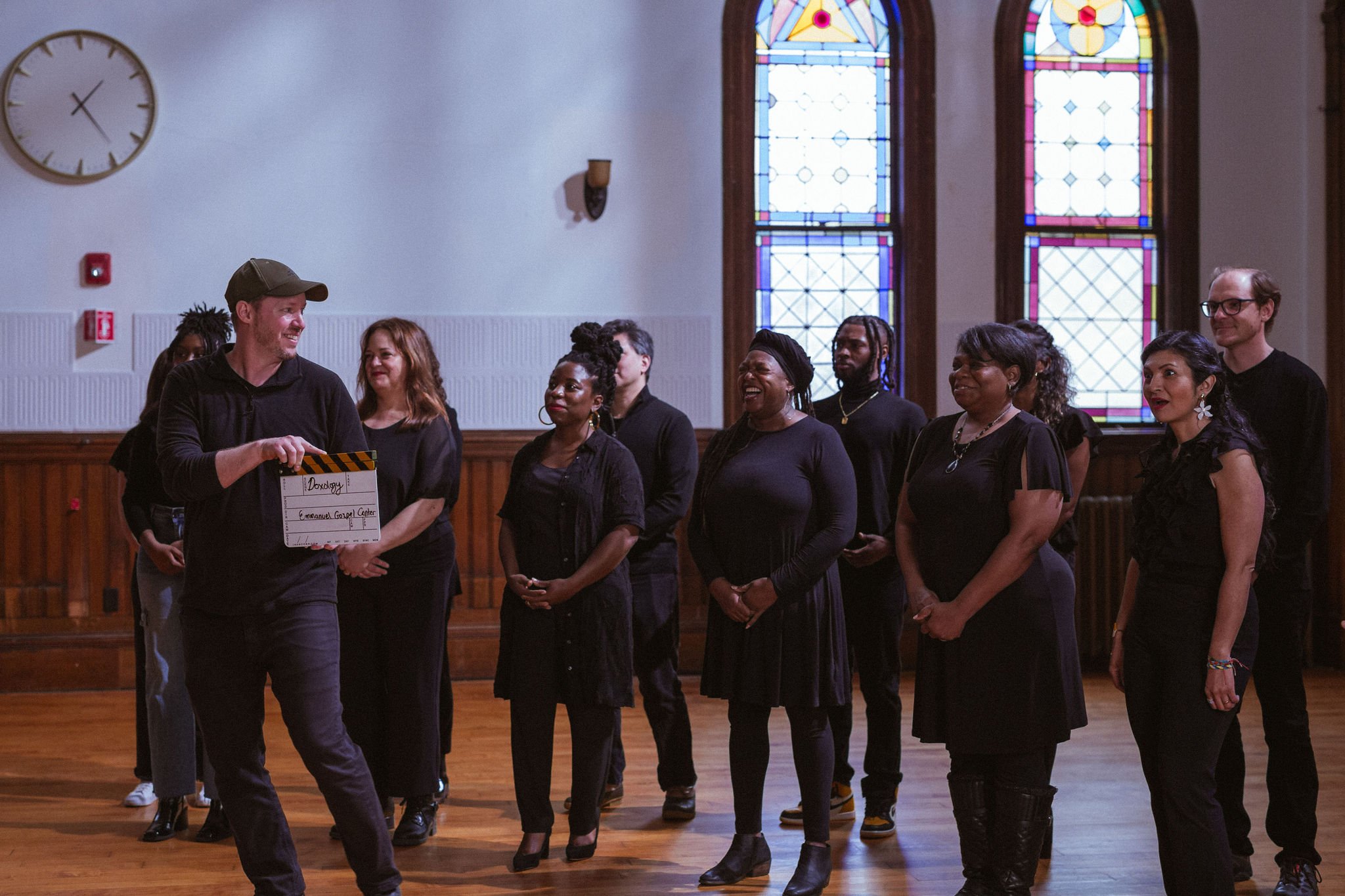
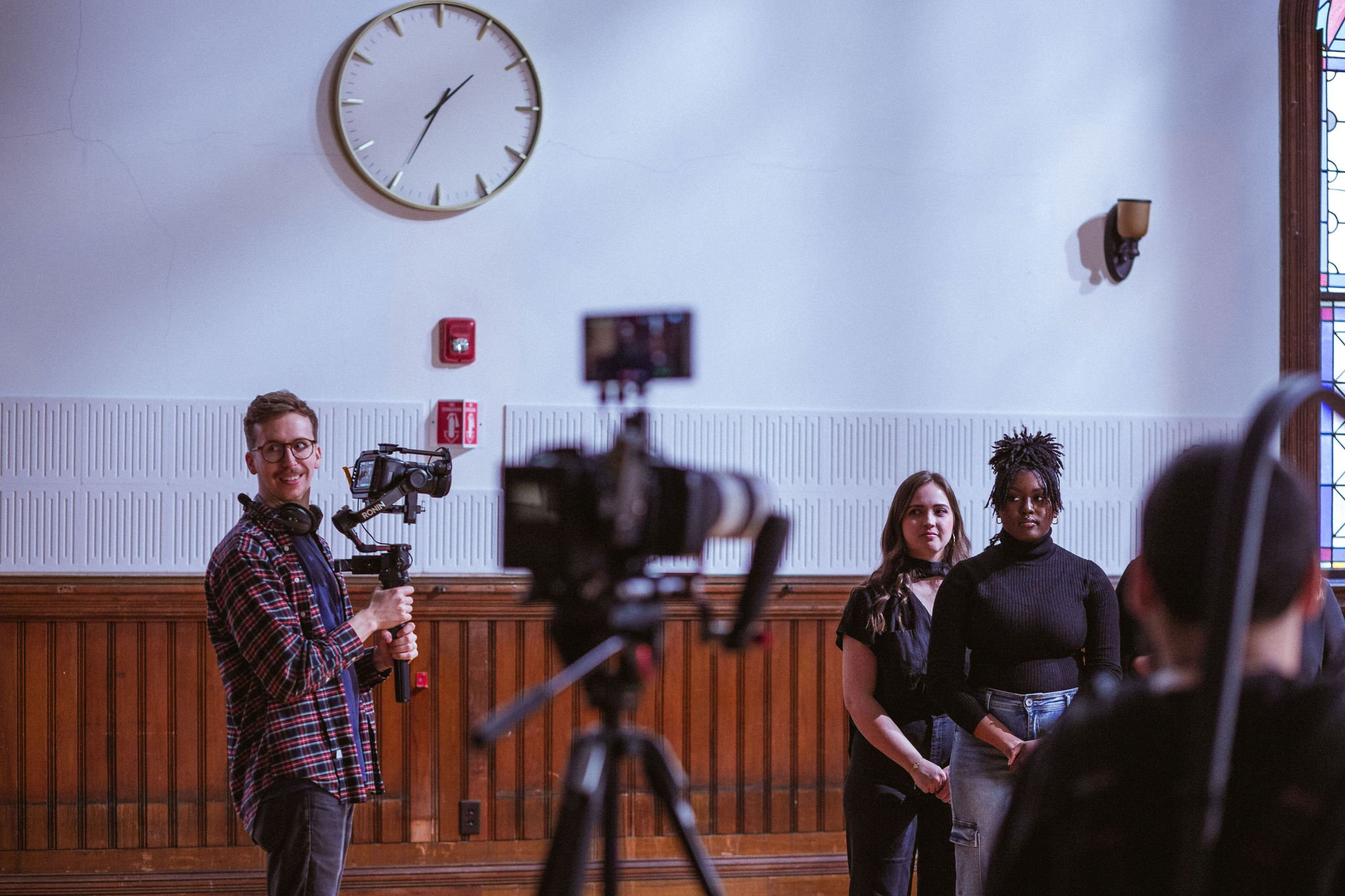
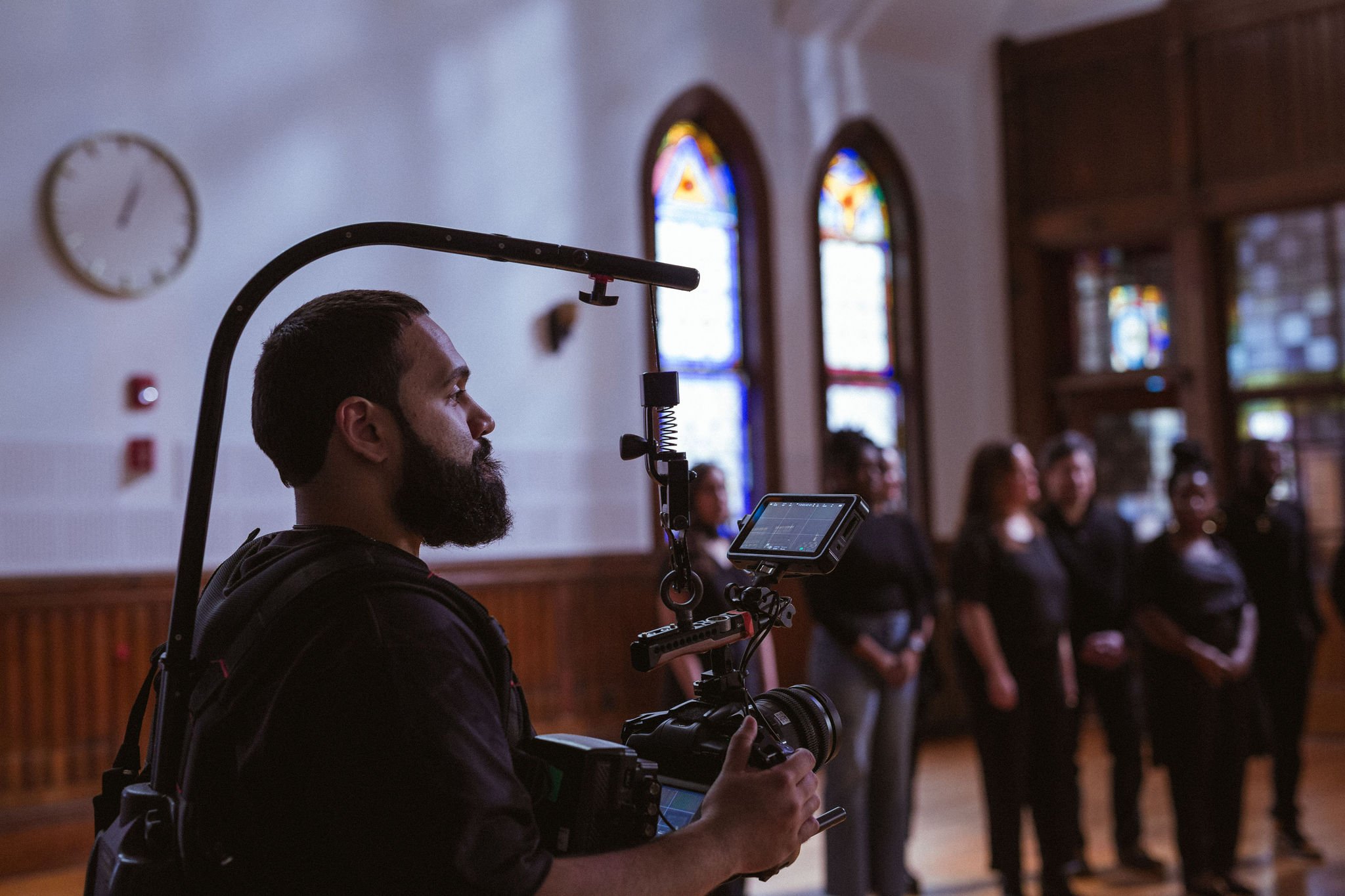
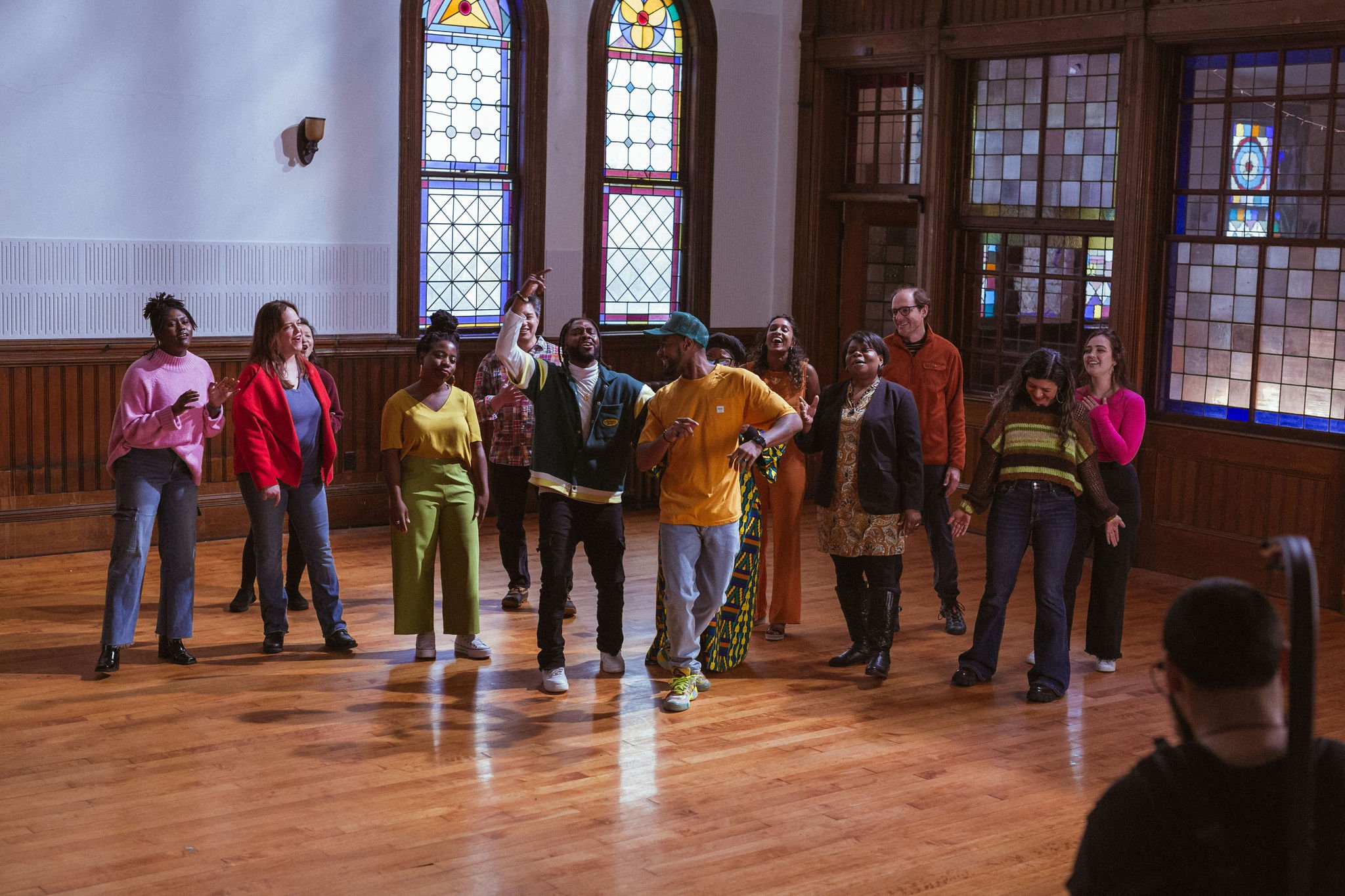
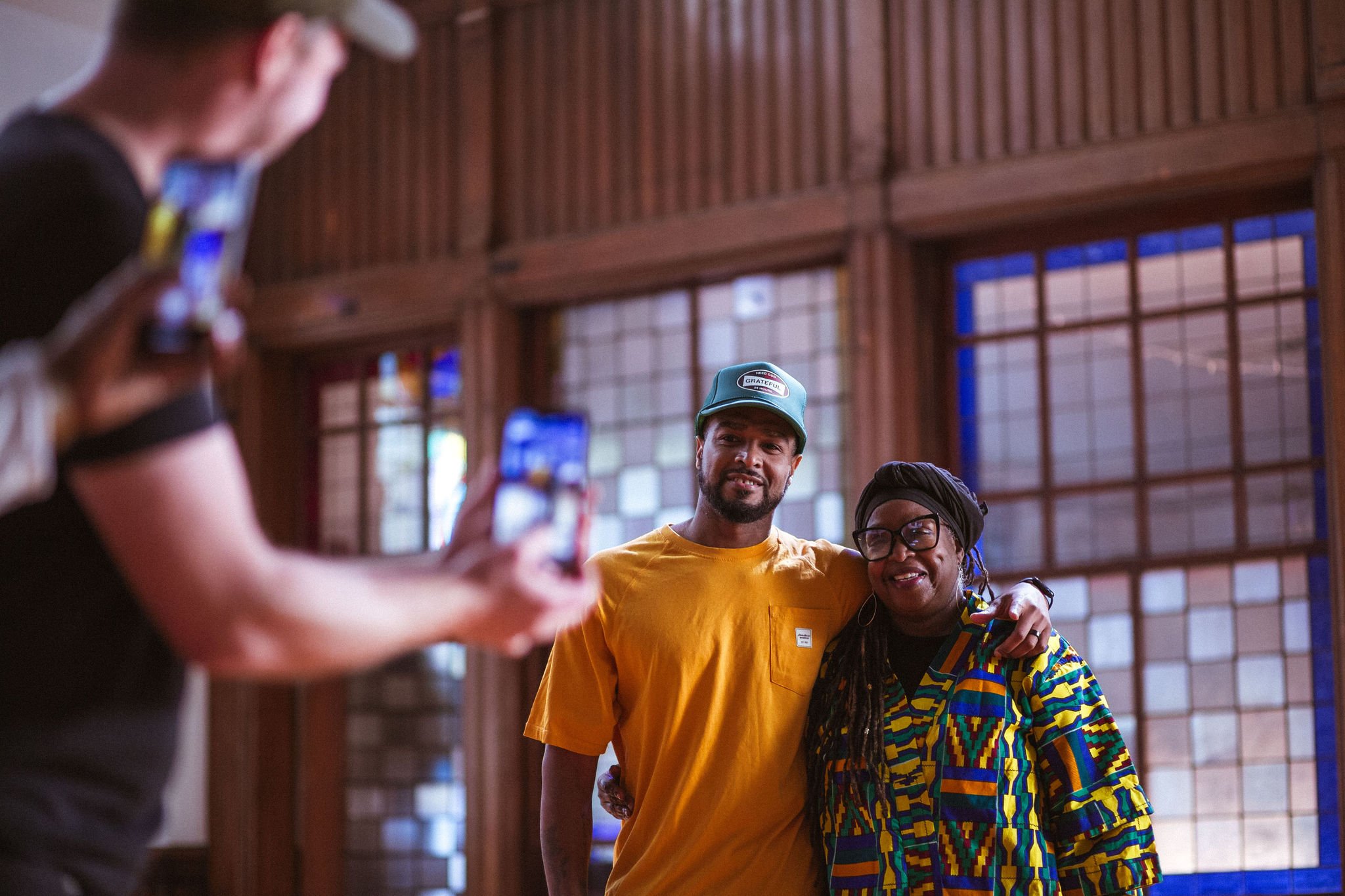

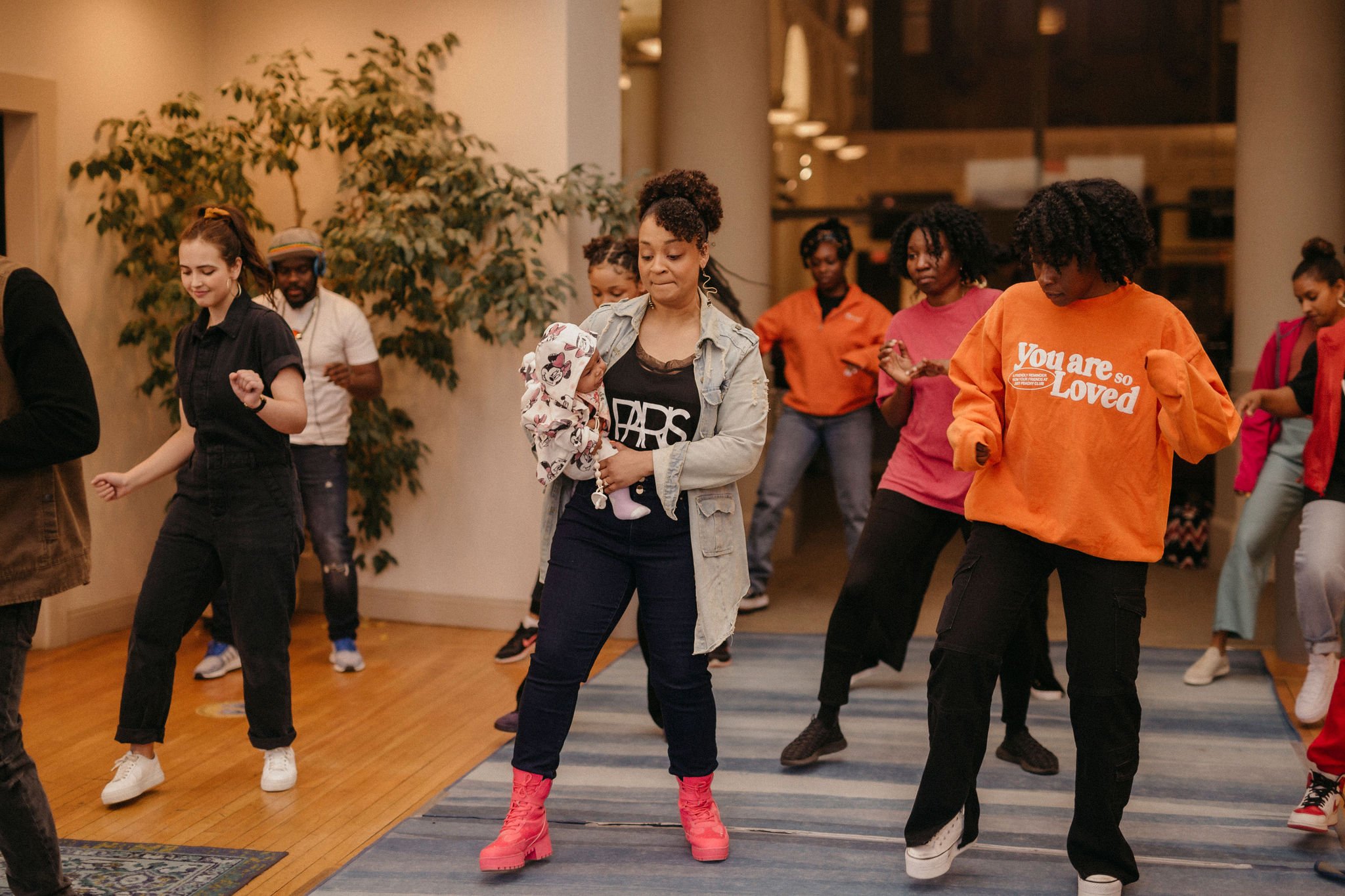
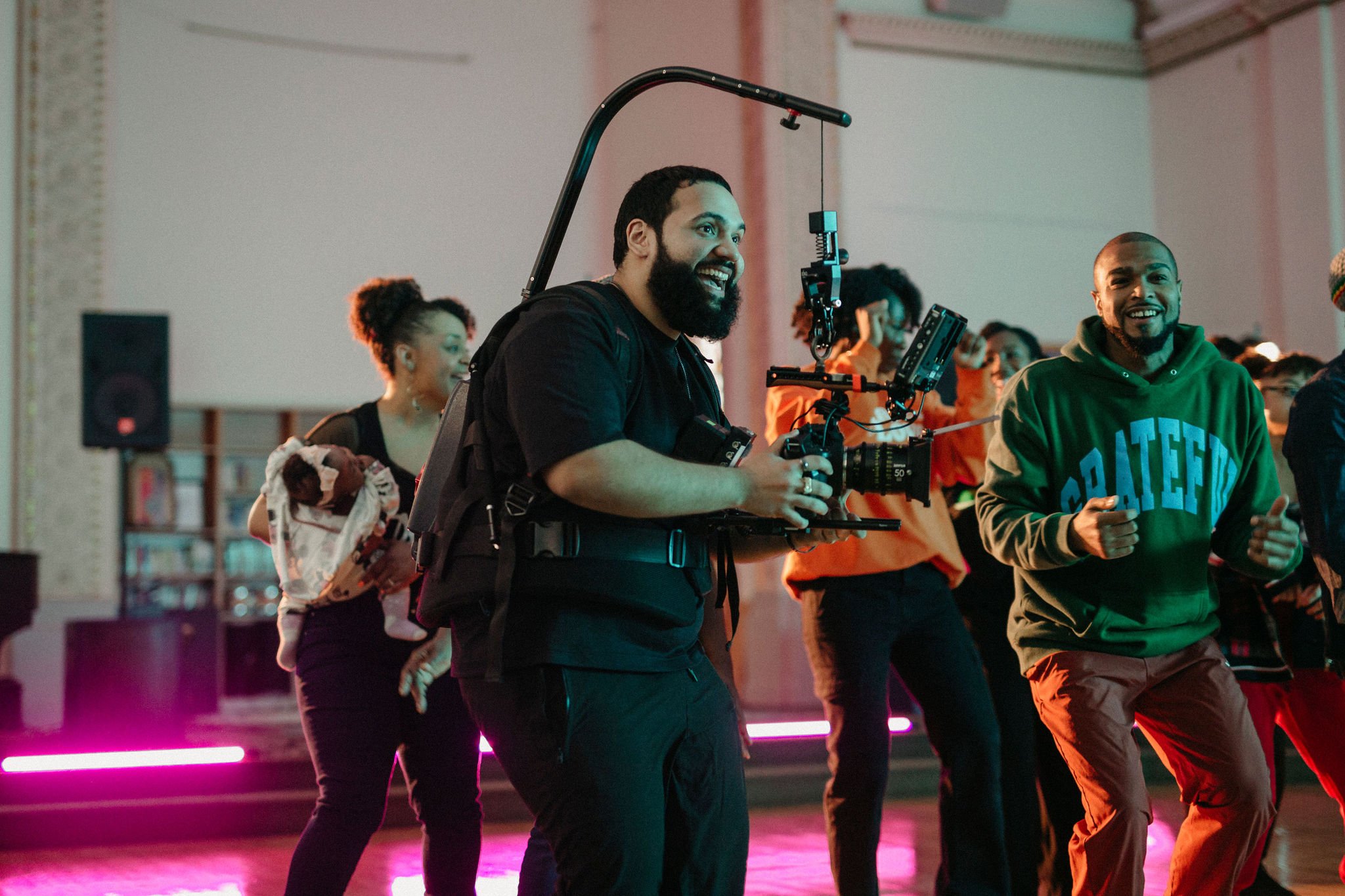
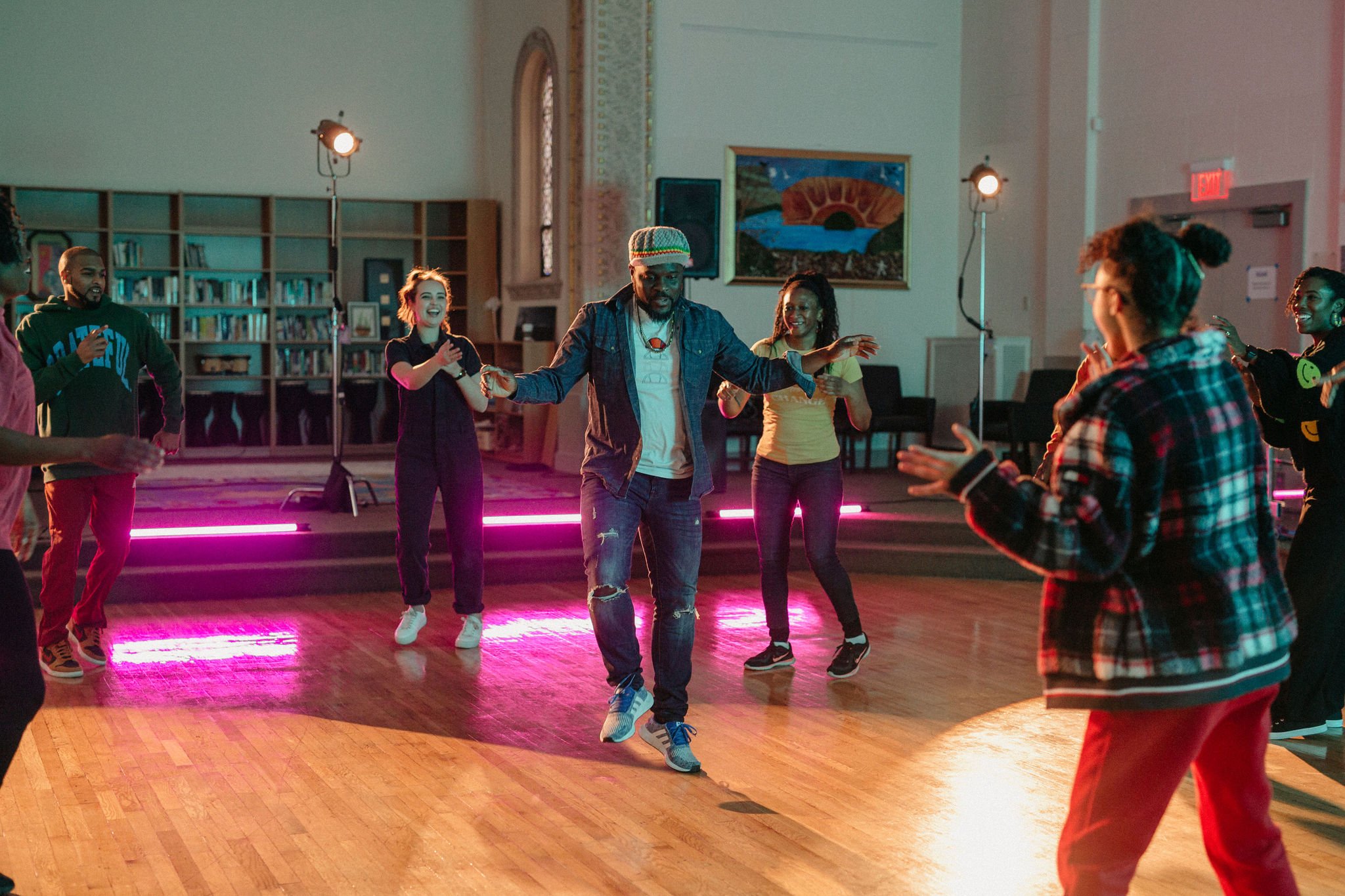
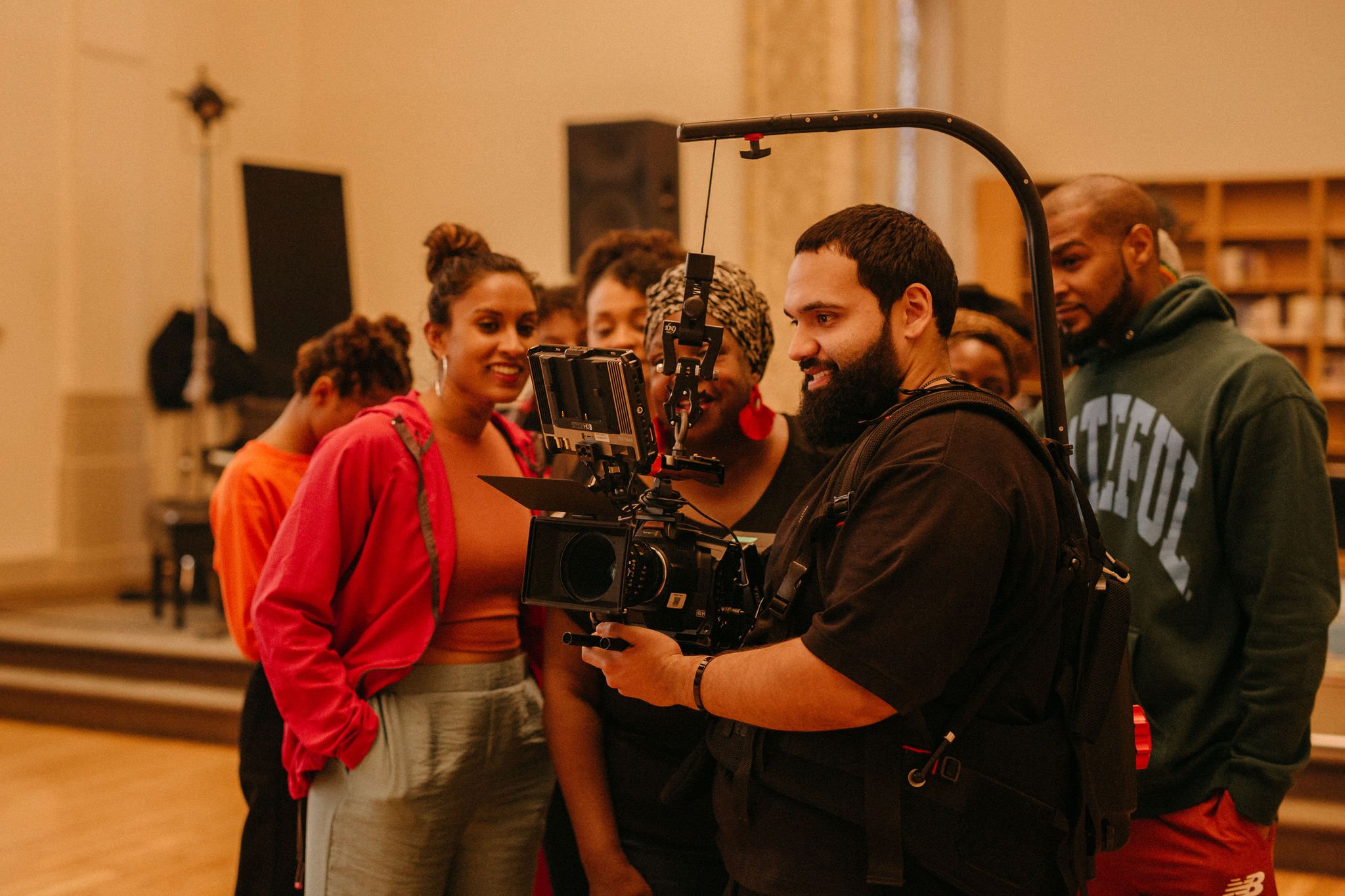





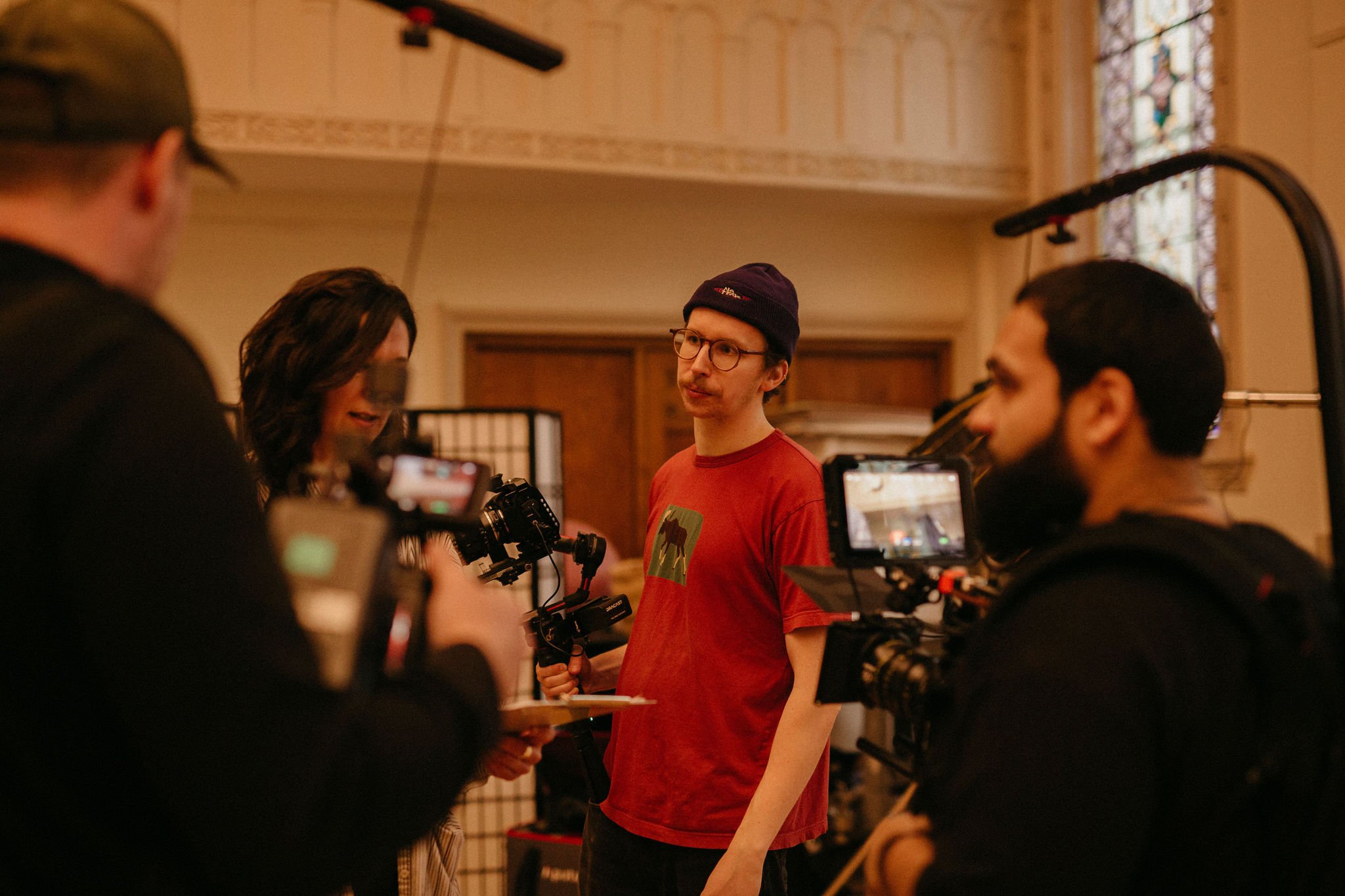
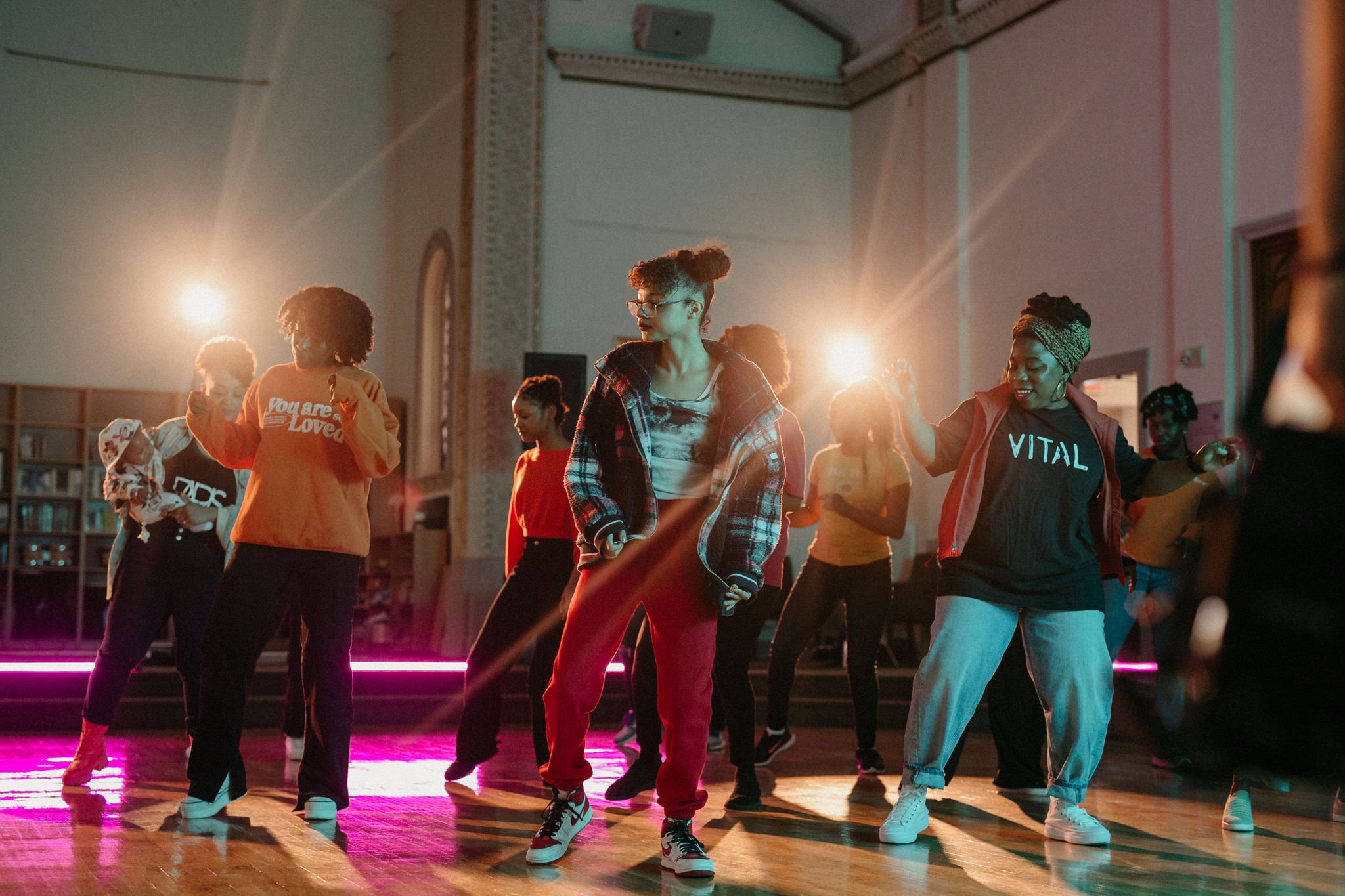

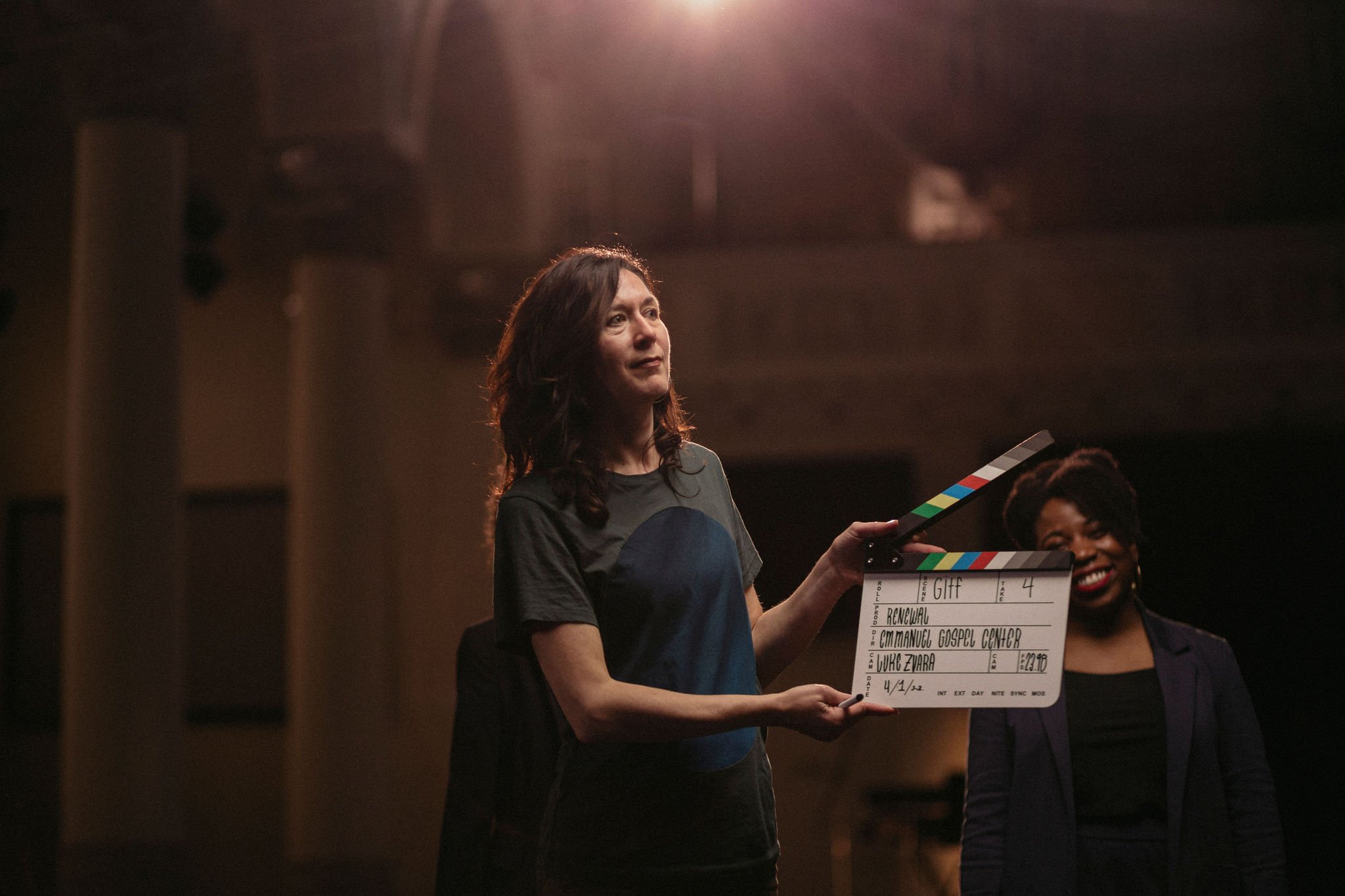

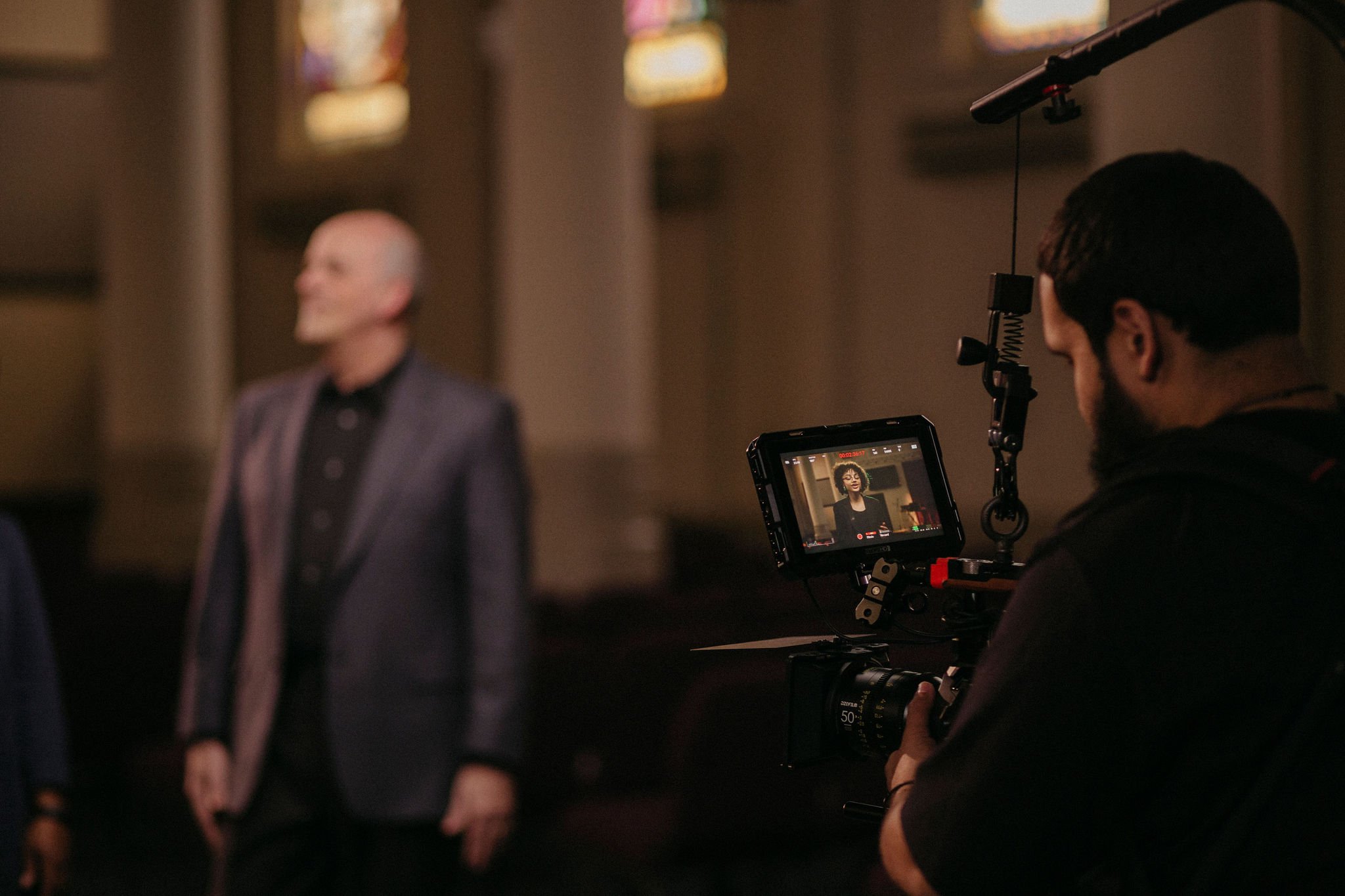
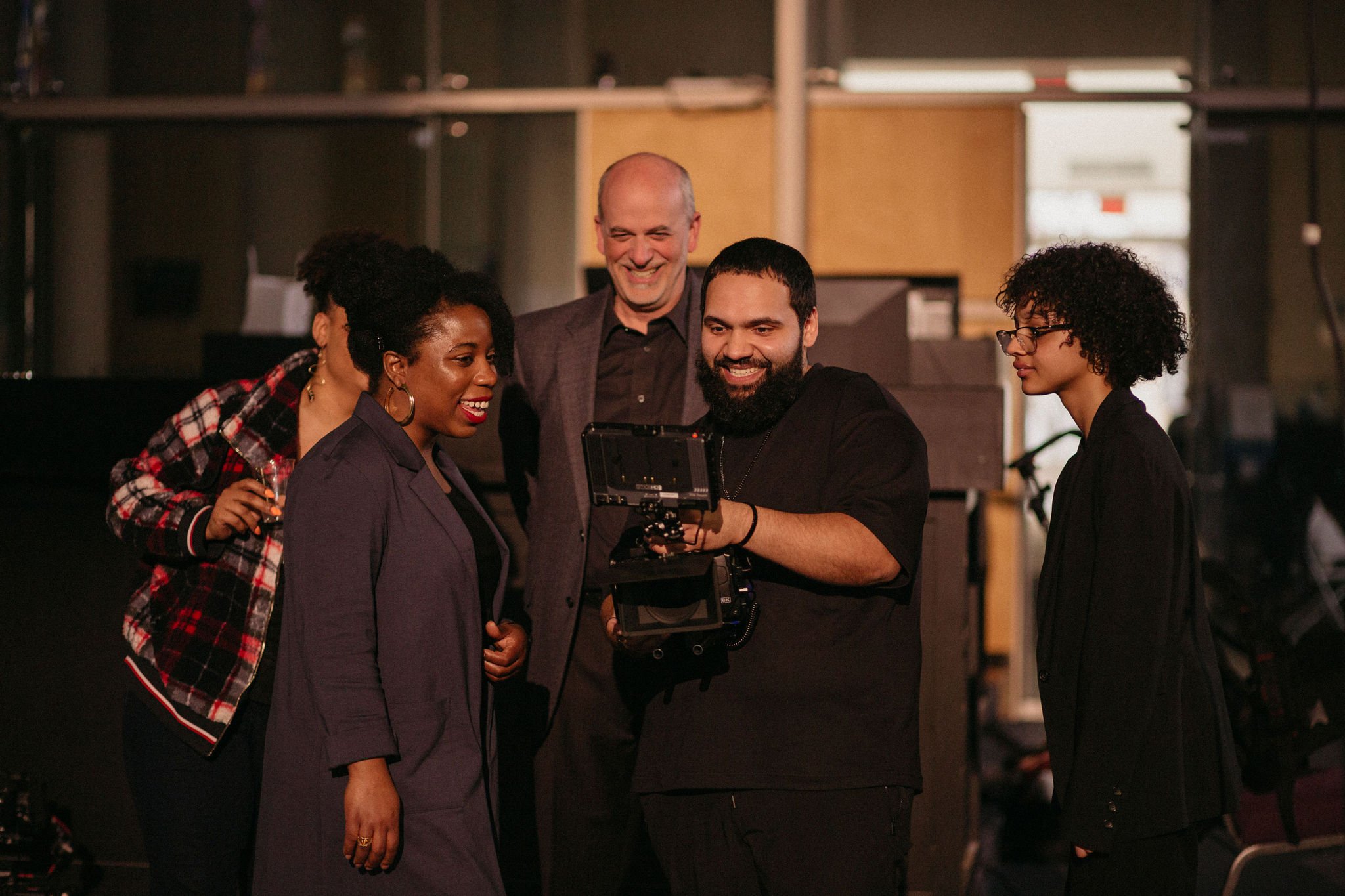
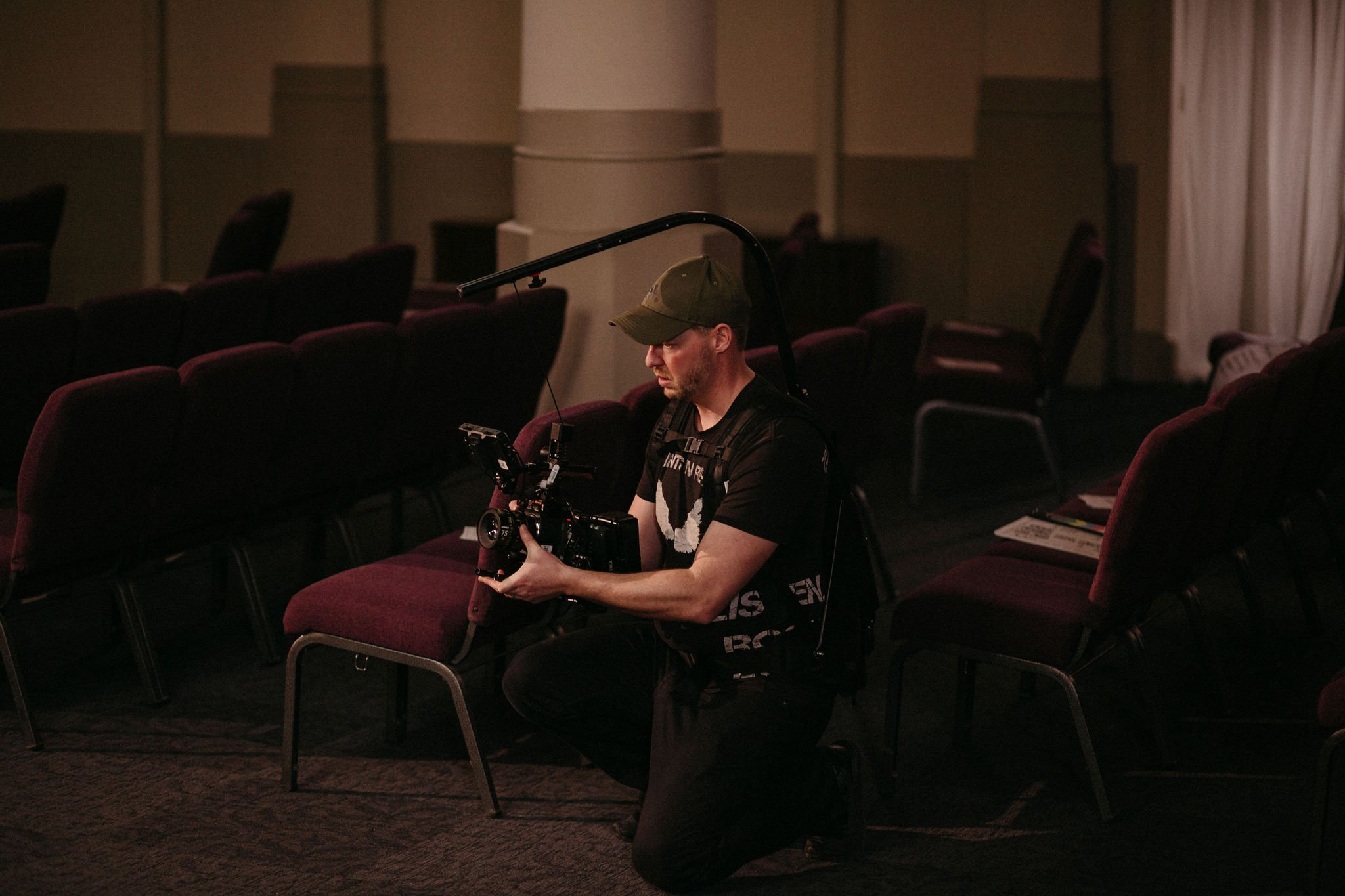



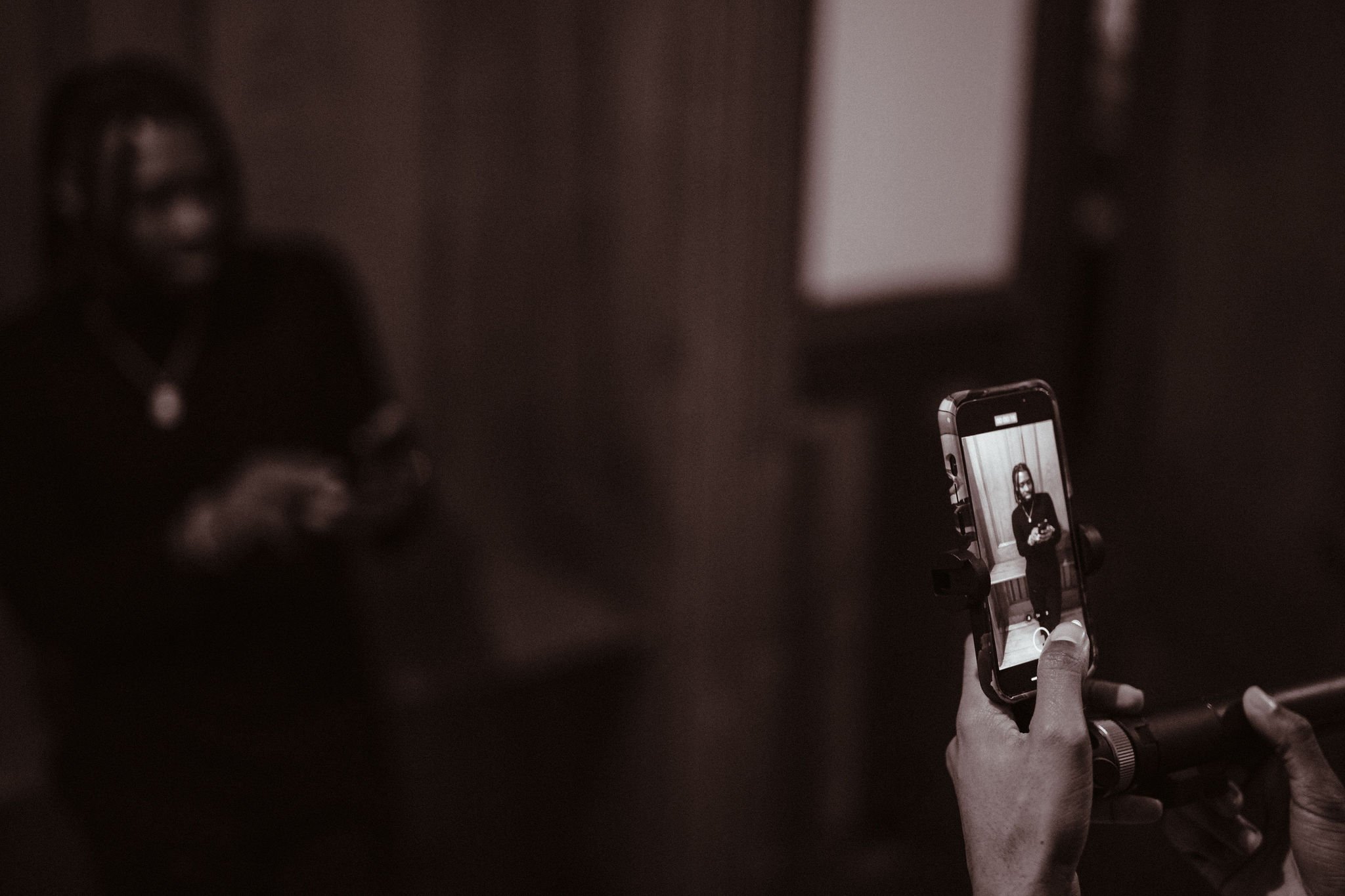
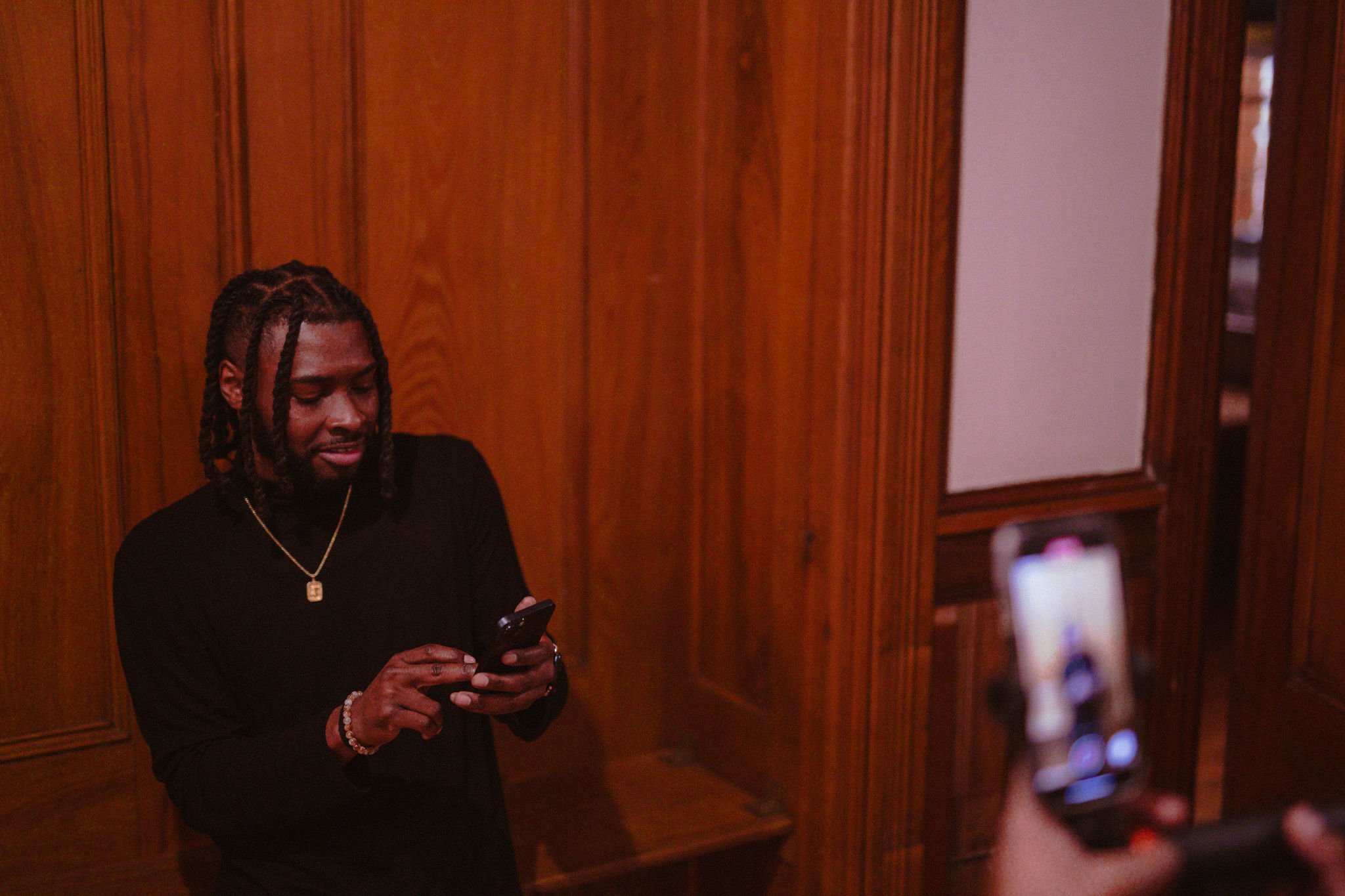

EGC film day in preparation for our annual fundraisers. Photography by Rosa Cabán at R9Foto.
Each year, we partner with different churches, which generously host us as we film content for our next fundraiser.
“It’s yet another point of connection and relationship-building that happens, where these relationships are leveraged and strengthened in the process to create something that will be a blessing beyond that moment,” says Saranya Sathananthan, researcher in residence at EGC. “Every church we’ve filmed in is aesthetically unique, and I do think that being in God’s house contributes to the quality and essence of his presence with us in the moment and in the feel of the final piece.”
Central Square Church’s historic building underwent a renovation in 2020, much like EGC’s fundraisers were remade for the pandemic era.
“Some sayin’ it’s the ending — I think it’s a new beginning.”
Originally the brainchild of Jeff Bass, EGC’s executive director, our annual fundraisers began as dinners hosted by multiple partner churches around the region.
(l-r) Hanna Garcia, Elijah Mickelson, Jalen Williams, Caleb McCoy. Photo credit: Rosa Cabán at R9Foto.
It was important to Jeff that the fundraiser not just raise funds but also advance the Center’s mission in multiple ways.
“I love that EGC’s fundraiser is missional for us,” he says. “It raises money for our work, yes, but it also invests in Christian creatives, provides a significant connecting opportunity for Christians throughout Greater Boston, and worships God by celebrating some of the ways we see Jesus at work in our city.”
Over time, we consolidated the fundraiser to one location. For several years, we held the event at Florian Hall in Dorchester or Jubilee Christian Church in Mattapan. (EGC staff members still have flashbacks of cleaning the expansive sanctuary with a household vacuum cleaner before resetting all the chairs for the next Sunday’s worship services.)
Then came the pandemic, and like everyone else, we had to pivot. Our 2020 fundraiser consisted of a single video, “Cry Out,” which included Caleb McCoy’s prophetic line, “Some sayin’ it’s the ending — I think it’s a new beginning.”
That meant rethinking our approach to content and gathering as a community.
“God has made us as individuals with different gifts that come to make up and culminate in the whole body. When we collab, we truly honor ourselves, we honor God, and we also bless others.”
Even before the pandemic, we had been moving away from presentations to embrace the diverse gifts of our staff members and ministry partners, adopting more creative content expressions.
But our next fundraiser marked a clear separation from the past. The pandemic was the first time we began working with local artists in a consistent, professional capacity, and we created a hybrid in-person and virtual concert event that resembled a drive-in movie theater experience.
Caleb, EGC’s marketing manager who wrote and performed “Cry Out,” says it’s a beautiful thing to collaborate with talented artists, dancers, filmmakers, musicians, poets, photographers, and singers.
“This has strengthened relationships among the Christian creative community, and continues to be a blessing in the city,” he says. “And to think, this largely came out of the chaos of COVID, when many artists shared the same uncertainty with their vocation and expression. It just shows how God continues to make beauty from ashes.”
Jen Aldana, singer, songwriter, and worship leader. Photo credit: Rosa Cabán at R9Foto.
For EGC staff, friends, and ministry partners, it’s a deeply meaningful experience.
“I am inspired by this unique space where filmmaking, art, and church community blend together to create something beautiful and sacred,” says Hanna Garcia, development manager at EGC.
“God has made us as individuals with different gifts that come to make up and culminate in the whole body,” says Giovanni Acevedo, poet, photographer, and filmmaker. “When we collab, we truly honor ourselves, we honor God, and we also bless others.”
“Performing and participating in EGC’s fundraiser event was an incredible blessing!” says Jen Aldana. “As a Boston-based artist, it was special to see my work come to life in a new way by creating an acoustic version of my song ‘Trust in You’ — a song about trusting in God through every season, with EGC’s vision. They stand true to their mission by incorporating the arts and empowering and uplifting others. . . It was truly a blessing to take part in.”
“As a Boston-based artist, it was special to see my work come to life in a new way.”
Each film day is a unique opportunity to connect with these artists. Saranya says she was blessed to catch up with them and hear about the latest in their lives.
Saranya Sathananthan. Photo credit: Rosa Cabán at R9Foto.
“It’s beautiful to see believers with different skills and active expressions of faith come together and contribute to something that uniquely demonstrates those talents and heartfelt stories while also reflecting a bigger picture of our amazing God and all he can do through those whose lives are surrendered to his purposes,” she says. “I left the time feeling full of joy.”
That joy sees the team through what can sometimes be a messy process of making the sausage.
“There’s a bit of chaos and feeling that spike of adrenaline, especially for those who are keeping track of the schedule, managing the equipment, and helping with all the logistics that are involved in making it happen,” Saranya says. “All these are things that you don’t really get a grasp of in seeing the final piece.”
Saranya says she’s wrestled with the filming process. It doesn’t always feel like a natural worship experience with all the bright lights and lidless, one-eyed cameras staring you down.
“But I’ve been surprised at how the Spirit often moves even in the constrained settings we often film under,” she says. “There was definitely a moment when our EGC choir was singing the Doxology together, hearing our voices magnified through the acoustics in the room, with Pastor Larry [Kim] and Laura [Mitchell] watching and singing along, that I felt like this was my sincere thanksgiving and worship to the Lord. I was grateful to be there with everyone amidst the non-stop laughter and great energy that was created together.”
As Saranya says, we hope this joyful creation and artistic expression “speak truth and encouragement to people in our collective moment and are also often timeless for those moments of needed encouragement.”
You can watch the concert anytime by subscribing to our YouTube channel.
The EGC board, staff, and friends choir at our 2024 film-day shoot. Photo credit: Rosa Cabán at R9Foto.
EGC’s (Inaugural) Shalom-Seekers Book List
Which books help you pursue the shalom of the city and the glory of God? Here are some titles that have contributed meaningfully to our shalom-seeking in Boston.
EGC’s (Inaugural) Shalom-Seekers Book List
Liza Cagua-McAllister for EGC staff
The Emmanuel Gospel Center (EGC) exists to catalyze kingdom-centered, systemic change for the shalom of the city and the glory of God. If you are also on this amazing mission, our staff recently put together a list of books that have influenced and helped us along this challenging journey!
We asked our team: What books from diverse authors have you read that have contributed meaningfully to your shalom-seeking in the urban context? Why were these books significant to you?
Submissions ranged from systems thinking primers to books on racial healing, from urban ministry classics to challenging new works less than a year old. From the 28 books mentioned by our team, we selected about a dozen to display in our EGC breakroom. Here are a few of those noteworthy titles, with staff comments.
“I find this book important for shalom-seeking in the urban context because... ”
A Multitude of All Peoples
A Multitude of All Peoples: Engaging Ancient Christianity's Global Identity by Vince L. Bantu (2020)
In order to know where we are headed, we need to know where we’ve been. Dr. Bantu — a former EGC staff member — brilliantly challenges Western mental models and makes the case for how the Church’s very foundation is multicultural.
Buried Seeds
Buried Seeds: Learning from the Vibrant Resilience of Marginalized Christian Communities by Alexia Salvatierra and Brandon Wrencher (2022)
Rev. Dr. Salvatierra and Rev. Wrencher glean powerful learnings from faith communities facing brutal challenges and evidencing tremendous power and imagination! From these historic movements, they offer present-day applications to different audiences, which is very helpful given urban shalom-seekers’ diverse experiences and social locations.
The Color of Compromise
The Color of Compromise: The Truth about the American Church’s Complicity in Racism by Jemar Tisby (2020)
Dr. Tisby offers an eye-opening and thoughtful account of how the Church has been complicit in creating and maintaining the unjust structures of systemic racism in America. This is an important book for understanding one of the key issues of our times.
Ecosystems of Jubilee
Ecosystems of Jubilee: Economic Ethics for the Neighborhood by Adam Gustine and José Humphreys III (2023)
The authors richly engage Scripture to address the relationship between justice and economics, which is so central to making things right in our world. We can’t really live out the gospel without having it reshape our economic ethics, and this is a great beginning!
Seek the Peace of the City
Seek the Peace of the City: Reflections on Urban Ministry by Dr. Eldin Villafañe (1995)
Dr. Villafañe applies the “Jeremiah paradigm” for ministry in the city, laying the biblical and theological groundwork for engaging issues such as violence and reconciliation in the city with the wisdom and truth of God’s word.
Thinking in Systems
Thinking in Systems: A Primer by Donella H. Meadows (2008)
We work in a complex web of interrelated living systems. Understanding systems is fundamental to our work, and this is the classic primer on what systems are and why they matter. It’s a great starting point or great refresher for your systems journey.
Other titles you can find in the EGC breakroom:
Beholding Beauty: Worshiping God through the Arts by Jason McConnell (2022)
Beyond Welcome: Centering Immigrants in our Christian Approach to Immigration by Karen González (2022)
First Nations Version: An Indigenous Translation of the New Testament trans. by Terry M. Wildman with consultant editor First Nations Version Translation Council (2021)
Healing Racial Trauma: The Road to Resilience Paperback by Sheila Wise Rowe (2020)
I Bring the Voices of My People: A Womanist Vision for Racial Reconciliation by Chanequa Walker-Barnes (2019)
The Alternative: Most of What You Believe About Poverty is Wrong by Mauricio Miller (2017)
The Anatomy of Peace: Resolving the Heart of Conflict by The Arbinger Institute (2006)
Come by EGC to borrow one of these copies, check them out at your local library, or purchase them at your local, independent bookstore through bookshop.org!
These books help us pursue the shalom of the city for the glory of God. How about you?
The Value and Relevance of Community Research
In-depth research helps us go below the surface.
Photo credit: Andrew Holzschuh via Lightstock
The Value and Relevance of Community Research
By Rudy Mitchell, Senior Researcher
Why research our communities when we can simply talk to people or make casual observations?
In-depth research helps us go below the surface. There we discover the root causes of problems, hidden needs, or little-known assets and resources.
Research provides a broader understanding of the various trends or forces impacting our communities. With this greater awareness, Christians can more effectively minister in their communities or start new ministries.
Community research lays a foundation for community transformation and effective witness.
This presentation is part of the larger series, Community Research and the Church. For earlier segments, click here.
The Nature of Community Research
What is community research?
Photo credit: Sam Ramsey via Lightstock
The Nature of Community Research
by Rudy Mitchell, Senior Researcher
Communities are complex social systems made up of people interacting with each other within a local area. The geographical context can be as small as a neighborhood or as large as an entire region.
As we learned in the first part of the Community Research and the Church series, community research includes various tools to learn more about your neighbors and community.
Community research is the systematic, careful study of a group of people who have common ties and social interactions, as well as the local area in which they live or interact.
How does this square with our Christian faith? God’s revelation provides a perspective on the world that informs our study of communities and culture. This biblical and theological research combined with community research helps us apply biblical principles and develop practical ministries in the church and community.
This presentation is part of the larger series, Community Research and the Church. In the next segment, we explore the value and relevance of community research.
Ministry With Eyes Wide Open: The Varied Lenses of Community Research
From community-based participatory research to social-network analysis, there are various ways Christians can learn more about the communities they serve.
Photo credit: Hamilton Photography via Lightstock
Ministry with Eyes Wide Open: The Varied Lenses of Community Research
by Rudy Mitchell, Senior Researcher
Are you seeing all that can be observed about your community?
From community-based participatory research to social-network analysis, there are various ways Christians can learn more about the communities they serve.
In this presentation, we explore several approaches to community research:
Spiritual and religious assessment
Historical-research approach
Demographic approach with mapping
Community-based participatory research
Assets-based approach
Needs-assessment approach
Community-indicators approach
Leadership studies and stakeholder analysis
Case studies of organizations and best practices
Social-network approach
Systems-analysis approach
A number of these approaches can be used as part of an overall community-building or community-development process that leads to community transformation.
This presentation is part of the larger series, Community Research and the Church. In the next segment, we explore the nature of community research and how it relates to biblical research and Christian ministry.
Community Research and the Church
A Christian church or ministry functions in the context of a particular community. To effectively minister in that community, it’s important to understand it.
Photo Credit: Athena Grace via Lightstock
Community Research and the Church
by Rudy Mitchell, Senior Researcher
A Christian church or ministry functions in the context of a particular community. To effectively minister in that community, it’s important to understand it.
There are various ways Christians can learn more about the communities they serve. Community research provides us with the tools to go below surface observations. It lays a foundation for community transformation and effective witness.
In this series, we explore several facets of community research: different approaches, its nature, and its value and relevance to the church.
Illustrated Guide for Researching Your Community
From population trends to social needs, this illustrated guide lists the factors to consider when learning more about a local neighborhood or community.
Photo credit: Boston Heath via Lightstock
by Rudy Mitchell, Senior Researcher
Click here for a template of a community research guide.
Community or Neighborhood Name:
Community geography
Clearly identify the boundaries of your community (geographical, political).
Identify the U.S. Census tracts of the community (unless you are covering a large area) or identify other defined areas used in population or demographic surveys.
Describe the main geographical features of the neighborhood or community. Describe any other basic defining characteristics or features. What key features (rivers, hills, waterfront, railroad, etc.) influence or define the nature and boundaries of the community?
Create or obtain a detailed map of the neighborhood or community. Add boundaries and use the base map to add other items of interest such as churches, schools, social service organizations, landmarks, cultural organizations, neighborhood associations, recreational facilities, and other resource assets. Separate maps can be created for different types of resources or institutions. You can also do this using layers in digital maps. You can use Google My Maps to create and share online maps. See google.com/mymaps. Another online option is to create a map in Harvard World Map, worldmap.harvard.edu, or Open Street Map, openstreetmap.org.
Grove Hall Boundaries and Census Tracts
Map of neighborhood churches
Examples of maps in a community study.
Map of Organizations and Programs in a Neighborhood
Key to map
Maps of schools, churches, and other institutions can be created, or these can be combined using symbols into one map.
Hawthorne Grove, the Marshall P. Wilder Estate
Community history
Research the community’s history using primary and secondary sources, as well as oral history interviews. Aspects of community history may include biographical information on significant people; the history of the built environment; the history of religious and cultural organizations; economic and political history; and the history of ethnic, racial, and social changes. The history can be presented in narrative form supplemented with maps, charts, and visual illustrations.
Old Blake House, Edward Everett Square, Dorchester
Overall population and population trends
What is the current total population of the community or neighborhood?
What overall population trends have occurred in the last several decades? Include earlier data if available. Explore possible reasons related to the changes and possible future trends.
| Decade | 1990 | 2000 | 2010 | Latest |
|---|---|---|---|---|
| Total population | ||||
| % change from previous decade |
[The formula for the % change is (B-A) /A x 100. Say the 1980 population (A) is 1,000 and the 1990 population (B) is 800. To find the percentage change from 1980 (A) to 1990 (B), begin on the calculator with B (800) and subtract A (1,000), then divide that by A (1,000) and multiply it by 100. You should get -20. You can add the percentage sign (%) to -20. The percentage change from A (1,000) to B (800) is -20%.]
Example of a line graph showing the population trend for a neighborhood study.
Ethnic and racial composition and trends of the community
Fill out this table for the major ethnic and racial groups in the community. (You may expand the table if you would like to include more groups, or you may combine smaller groups into an “Other” category.) Separate tables can be created for each census tract or for specific nationalities within the Hispanic group. Graphs and maps may also be used to visualize trends and changes. If the community has other nationalities and ethnic groups not listed in your table, you can list and describe them separately. Describe any intercultural or inter-racial tensions that exist. Summarize your observations and analysis of population trends.
| Name of group (ethnic group, racial group etc.) | 2000 | 2010 | Latest | pop. of group | % of total pop. | pop. of group | % of total pop. | pop. of group | % of total pop. |
|---|---|---|---|---|---|---|
| 1. | ||||||
| 2. | ||||||
| 3. | ||||||
| 4. | ||||||
| 5. | ||||||
| Total pop. | 100% | 100% | 100% | |||
The formula to find the percent is A/total x 100. Say 2,000 people (total) are in your community, and 250 (A) are Hispanic. Put 250 (A) on your calculator, divide by 2,000 (total), and multiply by 100. You should get 12.5. You can add the percent sign to your answer because you multiplied by 100. 250/2,000 x 100 = 12.5% of the people in your community are Hispanic. (Make sure your percentages total 100%.)
From this table, how has the ethnic and racial composition of the community changed in the last few decades? Summarize your observations and analysis of population trends.
Describe any intercultural or inter-racial tensions that exist.
Example of a graph showing racial trends in a neighborhood.
Languages spoken and linguistic isolation
What languages are spoken in the community? Provide numbers per language.
What number and percentage of the population are linguistically isolated? ( A household is linguistically isolated if all members 14 years and older speak a non-English language and they speak English less than “very well.”) Of those who are linguistically isolated, what percentages speak various languages other than English? What percentage of the population over 5 years speaks English less than “very well?”
What are the age characteristics of the community’s population?
Complete the following table to reveal any important differences between the age profile of the church, community, and nation. Use your personal estimate or ask your pastor for the church data. (Figure the percentages and make sure they add up to 100.) Do the percentages differ significantly between the church, the community, and the nation?
| Age category | Your church | Community | Nation | Number | % | Number | % | Number | % |
|---|---|---|---|---|---|---|
| 0-4 years | ||||||
| 5-9 years | ||||||
| 10-19 years | ||||||
| 20-34 years | ||||||
| 35-64 years | ||||||
| 65+ years | ||||||
| Total | 100% | 100% | 100% | |||
The formula to find the percent is A/total x 100. Say there are 200 people (total) in your church, and 25 (A) are youth. Put 25 (A) on your calculator, divide by 200 (total), and multiply by 100. You should get 12.5. You can add the percent sign to your answer because you multiplied by 100. 25/200 x 100 = 12.5% of your church are youth.
What is the current median age of the population? Compare this with the median age of the nation, state, and larger city, or metropolitan area. Compare median age differences between different races in the community (and between the Hispanic and non-Hispanic populations).
Observe more specific characteristics of the teenage and young adult populations, such as the racial and ethnic composition. Break down the age groups by single years.
Which generations are represented in significant numbers in your church? Is one generation dominant?
Baby Boomers, born 1946-1964
Generation X, born 1965-1980
Millennials, born 1981-1996
Generation Z, born 1997-2012
Examples of graphs showing age profiles and comparisons of a neighborhood.
Family Characteristics and Marital Status
What is the average household size in the community? What is the average household size in the individual census tracts or subsections of the community? Observe any variations and also compare with the metropolitan area, state, and nation.
What are the numbers and percentages of the population (over 15 years) in your community who are:
| Marital status | Number | % |
|---|---|---|
| Now married (except separated) | ||
| Single (never married) | ||
| Separated | ||
| Divorced | ||
| Widowed | ||
| Total population (over 15 years) | 100% |
Source:
What percentage of families consist of (Compare to total population: A/total x 100 = %)
Married couples with children (under 18 years)? %
Married couples without children (under 18 years)? %
Households
What is the total number of households?
What percentage of households are family households?
What percentage of households are non-family households?
How do these percentages compare with the state and national percentages?
How many family households have children under 18 years?
How many of these family households with children under 18 are female-headed with no male spouse present?
How many of these family households with children under 18 are male-headed with no female spouse present?
What number and percentage of family households with children under 18 are single-parent households?
Number:
%:
What percentage of children under 18 years living in households, lived with
Grandparents:
Other relatives:
Non-relatives:
Economics and Income
Poverty
What percentage of the population is living below the poverty level?
What percentage of youth age 18 and under are living below the poverty level?
What percentage of youth ages 12-17 are living below the poverty level?
Families: What is the total number of families? What is the number of families living below the poverty level? What percentage of families live below the poverty level?
Comparisons: How do the percentages above compare with the city, state, and national percentages? Do some parts of the study area have higher rates of poverty than others?
Income
What is the median family income in this community?
What is the mean (average) family income in this community?
| 2000 | 2010 | Latest | |
|---|---|---|---|
| Community | |||
| Metropolitan area | |||
| State | |||
| Nation |
Trends
Has the general income of the community changed significantly relative to wider trends? (Middle income to lower income, or gentrification, etc.)
Employment
Major employers or types of employers in the community?
What is the present rate of unemployment? %
Have there been any changes in the type of employment, location of employment, or unemployment rates?
Education
Highest level of education: What percentage of all persons over 25 years old have
Less than high school?
High school?
Bachelor’s degree?
Master’s degree or higher
How do these percentages compare with the national and state percentages?
Example of a graph comparing educational achievements.
What is the current event drop-out rate for any high schools in the community?
Research the elementary and secondary educational institutions in the community.
List and describe each school. Provide any statistical data available.
List any postsecondary educational institutions and their enrollment.
Jeremiah Burke High School
Housing
What are the major housing types in the community based on your observation? (High-rise apartments or public housing; single-family detached houses, rowhouses, duplexes, triple-deckers, etc.)
What percentage of the housing units are owner-occupied? % (Compare to total)
What percentage of the housing units are low-income or affordable? % (Compare to total)
What is the median housing value for the community? For the nation?
Is the housing value increasing, decreasing, or stable?
What are the current typical monthly rental costs for a
Studio:
One-bedroom:
Two-bedroom:
Or more bedrooms
What housing needs and problems does the community have?
Recreation
List any important recreational facilities and activities in the community:
Source:
Community events
List major community events that occur annually or regularly:
Source:
Organizations
List any major community organizations, neighborhood associations, clubs, social, political, or educational groups:
Source:
Media
How are events in the community publicized?
Is there a community newspaper?
Source:
Social Needs
List any important Social Service Agencies and their services:
Source:
List three social needs that are not being effectively met by these groups.
Source:
What are the major crime concerns in the neighborhood?
Source:
Click here for a template of a community research guide.
Guide for Researching Your Community
From population trends to social needs, this guide lists the factors to consider when learning more about a local neighborhood or community.
Photo credit: JYount Photo via Lightstock
by Rudy Mitchell, Senior Researcher
Click here for an illustrated guide to researching your community.
Community or Neighborhood name:
Community geography
Clearly identify the boundaries of your community (geographical, political).
Identify the U.S. Census tracts of the community (unless you are covering a large area) or identify other defined areas used in population or demographic surveys.
Describe the main geographical features of the neighborhood or community. Describe any other basic defining characteristics or features. What key features (rivers, hills, waterfront, railroad, etc.) influence or define the nature and boundaries of the community?
Create or obtain a detailed map of the neighborhood or community. Add boundaries and use the base map to add other items of interest such as churches, schools, social service organizations, landmarks, cultural organizations, neighborhood associations, recreational facilities, and other resource assets. Separate maps can be created for different types of resources or institutions. You can also do this using layers in digital maps. You can use Google My Maps to create and share online maps. See google.com/mymaps. Another online option is to create a map in Harvard World Map, worldmap.harvard.edu, or Open Street Map, openstreetmap.org.
Community history
Research the community’s history using primary and secondary sources, as well as oral history interviews. Aspects of community history may include biographical information on significant people; the history of the built environment; the history of religious and cultural organizations; economic and political history; and the history of ethnic, racial, and social changes. The history can be presented in narrative form supplemented with maps, charts, and visual illustrations.
Overall population and population trends
What is the current total population of the community or neighborhood?
What overall population trends have occurred in the last several decades? Include earlier data if available. Explore possible reasons related to the changes and possible future trends.
| Decade | 1990 | 2000 | 2010 | Latest |
|---|---|---|---|---|
| Total population | ||||
| % change from previous decade |
[The formula to find the % change is (B-A) /A x 100. Say the 1980 population (A) is 1,000 and the 1990 population (B) is 800. To find the percentage change from 1980 (A) to 1990 (B), begin on the calculator with B (800) and subtract A (1,000), then divide that by A (1,000) and multiply by 100. You should get -20. You can add the percentage (%) sign to -20. The percentage change from A (1,000) to B (800) is -20%.]
Ethnic and Racial composition and trends of the community
Fill out this table for the major ethnic and racial groups in the community. (You may expand the table if you would like to include more groups, or you may combine smaller groups into an “Other” category.) Separate tables can be created for each census tract or for specific nationalities within the Hispanic group. Graphs and maps may also be used to visualize trends and changes. If the community has other nationalities and ethnic groups not listed in your table, you can list and describe them separately. Describe any intercultural or inter-racial tensions that exist. Summarize your observations and analysis of population trends.
| Name of group (ethnic group, racial group etc.) | 2000 | 2010 | Latest | pop. of group | % of total pop. | pop. of group | % of total pop. | pop. of group | % of total pop. |
|---|---|---|---|---|---|---|
| 1. | ||||||
| 2. | ||||||
| 3. | ||||||
| 4. | ||||||
| 5. | ||||||
| Total pop. | 100% | 100% | 100% | |||
The formula to find the percent is A/total x 100. Say there are 2,000 people (total) in your community, and 250 (A) are Hispanic. Put 250 (A) on your calculator, divide by 2,000 (total), and multiply by 100. You should get 12.5. You can add the percentage (%) sign to your answer because you multiplied by 100. 250/2,000 x 100 = 12.5% of the people in your community are Hispanic. (Make sure your percentages total 100%.)
From this table, how has the ethnic and racial composition of the community changed in the last few decades? Summarize your observations and analysis of population trends.
Describe any intercultural or inter-racial tensions that exist.
Languages spoken and linguistic isolation
What languages are spoken in the community? Provide numbers per language.
What number and percentage of the population are linguistically isolated? ( A household is linguistically isolated if all members 14 years and older speak a non-English language and they speak English less than “very well.”) Of those who are linguistically isolated, what percentages speak various languages other than English? What percentage of the population over 5 years speaks English less than “very well?”
What are the age characteristics of the community’s population?
Complete the following table to reveal any important differences between the age profile of the church, community, and nation. Use your personal estimate or ask your pastor for the church data. (Figure the percentages and make sure they add up to 100.) Do the percentages differ significantly between the church, the community, and the nation?
| Age category | Your church | Community | Nation | Number | % | Number | % | Number | % |
|---|---|---|---|---|---|---|
| 0-4 years | ||||||
| 5-9 years | ||||||
| 10-19 years | ||||||
| 20-34 years | ||||||
| 35-64 years | ||||||
| 65+ years | ||||||
| Total | 100% | 100% | 100% | |||
The formula to find the percent is A/total x 100. Say there are 200 people (total) in your church, and 25 (A) are youth. Put 25 (A) on your calculator, divide by 200 (total), and multiply by 100. You should get 12.5. You can add the percentage (%) sign to your answer because you multiplied by 100. 25/200 x 100 = 12.5% of your church is youth.
What is the current median age of the population? Compare this with the median age of the nation, state, and larger city, or metropolitan area. Compare median age differences between different races in the community (and between the Hispanic and non-Hispanic populations).
Observe more specific characteristics of the teenage and young adult populations, such as the racial and ethnic composition. Break down the age groups by single years.
Which generations are represented in significant numbers in your church? Is one generation dominant?
Baby Boomers, born 1946-1964
Generation X, born 1965-1980
Millennials, born 1981-1996
Generation Z, born 1997-2012
Family Characteristics and Marital Status
What is the average household size in the community? What is the average household size in the individual census tracts or subsections of the community? Observe any variations and also compare with the metropolitan area, state, and nation.
What are the numbers and percentages of the population (over 15 years) in your community who are:
| Marital status | Number | % |
|---|---|---|
| Now married (except separated) | ||
| Single (never married) | ||
| Separated | ||
| Divorced | ||
| Widowed | ||
| Total population (over 15 years) | 100% |
Source:
What percentage of families consist of (Compare to total population: A/total x 100 = %)
Married couples with children (under 18 years)? %
Married couples without children (under 18 years)? %
Households
What is the total number of households?
What percentage of households are family households?
What percentage of households are non-family households?
How do these percentages compare with the state and national percentages?
How many family households have children under 18 years?
How many of these family households with children under 18 are female-headed with no male spouse present?
How many of these family households with children under 18 are male-headed with no female spouse present?
What number and percentage of family households with children under 18 are single-parent households?
Number:
%:
What percentage of children under 18 years living in households, lived with
Grandparents:
Other relatives:
Non-relatives:
Economics and income
Poverty
What percentage of the population is living below the poverty level?
What percentage of youth age 18 and under are living below the poverty level?
What percentage of youth ages 12-17 are living below the poverty level?
Families: What is the total number of families? What is the number of families living below the poverty level? What percentage of families live below the poverty level?
Comparisons: How do the percentages above compare with the city, state, and national percentages? Do some parts of the study area have higher rates of poverty than others?
Income
What is the median family income in this community?
What is the mean (average) family income in this community?
| 2000 | 2010 | Latest | |
|---|---|---|---|
| Community | |||
| Metropolitan area | |||
| State | |||
| Nation |
Trends
Has the general income of the community changed significantly relative to wider trends? (Middle income to lower income, or gentrification, etc.)
Employment
Major employers or types of employers in the community?
What is the present rate of unemployment? %
Have there been any changes in the type of employment, location of employment, or unemployment rates?
Education
Highest level of education: What percentage of all persons over 25 years old have
Less than high school?
High school?
Bachelor’s degree?
Master’s degree or higher
How do these percentages compare with the national and state percentages?
What is the current event drop-out rate for any high schools in the community?
Research the elementary and secondary educational institutions in the community.
List and describe each school. Provide any statistical data available.
List any postsecondary educational institutions and their enrollment.
Housing
What are the major housing types in the community based on your observation? (High-rise apartments or public housing; single-family detached houses, rowhouses, duplexes, triple-deckers, etc.)
What percentage of the housing units are owner-occupied? % (Compare to total)
What percentage of the housing units are low-income or affordable? % (Compare to total)
What is the median housing value for the community? For the nation?
Is the housing value increasing, decreasing, or stable?
What are the current typical monthly rental costs for a
Studio:
One-bedroom:
Two-bedroom:
Or more bedrooms
What housing needs and problems does the community have?
Recreation
List any important recreational facilities and activities in the community:
Source:
Community events
List major community events that occur annually or regularly:
Source:
Organizations
List any major community organizations, neighborhood associations, clubs, social, political, or educational groups:
Source:
Media
How are events in the community publicized?
Is there a community newspaper?
Source:
Social Needs
List any important Social Service Agencies and their services:
Source:
List three social needs that are not being effectively met by these groups:
Source:
What are the major crime concerns in the neighborhood?
Source:
Click here for an illustrated guide to researching your community.
Finding a flower in the crack
A discussion group for people involved in the child welfare system in Boston has led to collaboration as members learn from each other and better understand the system which affects their lives and directs their work.
Photo credit: KevinCarden via Lightstock
Finding a flower in the crack
A story of shared humanity within the child welfare ecosystem
by Kay Rideout
One meeting — that’s all they agreed to in the beginning.
On Feb. 26, 2018, an email from Liza Cagua-Koo of the Emmanuel Gospel Center (EGC) pinged the inboxes of six individuals intertwined with the child welfare system in Greater Boston. A suburban fostering grandmother with the church-based initiative Home for Good. An urban bivocational pastor and social worker with the Massachusetts Adoption Resource Exchange (MARE). A leader from the New England Christian non-profit Fostering Hope. A certified counselor and foster parent.
The email extended an open-ended invitation.
“You are receiving this email because I or someone else on this list knows about your engagement in supporting & recruiting families doing foster care and/or adoption,” Cagua-Koo wrote. “I don’t have an agenda for this time – the goal is for you to connect….”
Recognizing the opportunity to build on shared connections and passions, the group agreed to meet in MARE’s Newton offices the following month.
Before this meeting, individuals in the group had experienced the weight of the child welfare system — each from a different vantage point.
As a kinship foster parent, Wendy Jacobi knew the difficulties facing children and families in the system and the lack of available resources. For 17 years, Jacobi and her husband have worked to build support systems encompassing neuropsychologists, developmental pediatricians, and childcare workers.
For years, Rev. Dr. Ricardo Franco recognized the need for cross-system collaboration between churches and child welfare workers but found that the timing was never quite right. Letters, emails, and intentional conversations led to few open doors.
“It really is invaluable. Just having a space where people feel comfortable, where they feel safe, where they truly feel like they can share their thoughts — even if they haven’t fully grappled with them.”
Never envisioning himself in the world of foster care, Jonathan Reid began his journey as a foster parent with negative assumptions surrounding both children in the system and their families. Through interactions and first-hand experiences with these families, Reid became passionate about helping to reframe churches’ perceptions of children and families within the child welfare system: a desire which has since led him to develop the Fostering Hope initiative.
Though individual, their experiences represent patterns of pain and complexity embedded in the child welfare system.
Like many complex systems, the child welfare system can often feel concrete: heavy, immovable, challenging to navigate, and often built on conflicting agendas. A system where families are both separated and supported — where turnover rates are high, emotional and professional burnouts are frequent, and change is glacial.
But life, movement, and beauty are still at work in heavy, inflexible spaces. Despite the difficult realities in every system, there are moments when the concrete cracks long enough for a flower to take root in the gap.
On that day in 2018, eight individuals, connecting on shared hopes and experiences, discovered a crack in the concrete.
“I prayed for this and I (had) been waiting for this — more than pray … I yearned for this,” Franco said. “I longed for this in my heart from the very beginning, but I didn’t feel like it (had) any echo, any resonance with other people.”
One meeting turned into two, and two turned into a series of monthly meetings arranged over four years — interrupted by COVID-19 but not derailed.
The group’s structure was organic and relational: formed by Cagua-Koo and Franco’s intentional decisions to empower all the voices and individuals in the room. This context, set apart from the whirlwind of personal and professional responsibilities, cultivated honest discussions.
“(Systems language has) definitely made a big difference in (Fostering Hope’s) thinking and planning as an org. I’m regularly thinking about some of these simple baseline questions like, ‘OK, what’s an unintended consequence if we do this? Who is this going to affect that we wouldn’t want it to affect?’”
“It really is invaluable,” former Fostering Hope Programs Coordinator Ana Maria Tormes said. “Just having a space where people feel comfortable, where they feel safe, where they truly feel like they can share their thoughts — even if they haven’t fully grappled with them.”
More people entered into the conversation as members and guest speakers — individuals from different backgrounds, communities, roles, beliefs, and experiences — who could together better understand the system which affected their lives and directed their work.
A dozen individuals participate in this space today. Group members have come and gone as needed, introducing friends, co-workers, and supervisors along the way.
Years later, the fruit that has come from the group can be seen internally and through participating leaders’ efforts.
Connection has led to collaboration: both within the group and with those outside of it.
Group members have shared insights and resources at Vision New England’s forums that connect Christian leaders across the region interested in engaging the foster care space. They have successfully supported one another throughout the COVID-19 pandemic: working together and coaching one another as they transitioned from exclusively in-person events to virtual spaces that effectively engaged new families.
But while these collaborative, external accomplishments are significant, leaders in the group consistently point to the internal, personal and relational fruit that has formed within and between them.
Intellectually, group members were exposed to systems models that help articulate and inform the ecosystem in which they operate. Discussions surrounding differences between urban and suburban strategies, characteristics that define supportive foster families, and best practices for church–agency collaborations have given new language and ways of thinking to those involved in the conversations. Group members are not just sharing what they already know but revealing new insights and points of leverage in their discussions with one another.
“I can read books about strategies and how to support families, how to recruit families — there are tons of materials … but this has been my best social work education in terms of bringing the humanity of the field in front of me.”
“(Systems language has) definitely made a big difference in (Fostering Hope’s) thinking and planning as an org.,” Reid said. “I’m regularly thinking about some of these simple baseline questions like, ‘OK, what’s an unintended consequence if we do this? Who is this going to affect that we wouldn’t want it to affect?’”
The intellectual curiosity this learning requires has served the group well as individuals engage their own stereotypes, preconceived narratives, and misplaced assumptions. As people from different spaces in the child welfare system and the broader systems serving urban families gathered in one room, shared stories and experiences quickly began to challenge individual perspectives.
For Jacobi, one of the most significant moments of learning took place when a family case worker was invited to share the complexity and weight of her role with members of the group. “She talked about her trauma — that she had been traumatized [by her job] had never occurred to me … I so wanted to weep for this woman,” Jacobi said. “That to me was the moment that made me say, ‘I understand it now.’”
In conversation with eight other group members, each voiced this same perspective–shift — this expansion of worldview that has added new layers of complexity to their perceptions surrounding other individuals, churches, organizations, institutions and families interacting in the child welfare ecosystem.
“I learned so quickly from the insights (and) from these other folks sharing their perspective,” Reid said. “Adding insights and ideas and concepts and perspectives that I would have not ever known or thought of had I not been at a table with them and in a space where we could kind of quietly listen and learn from each other.”
Cagua-Koo noted that the work of listening to one another and “humanizing” individuals within the group has been a critical outcome.
Franco echoed this idea. “The learning for me has been the (human) part — the humanity of all the players,” Franco said. “Because you know what? I can read books about strategies and how to support families, how to recruit families — there are tons of materials … but this has been my best social work education in terms of bringing the humanity of the field in front of me.”
Shared humanity has brought more than a perspective shift: it has brought healing, compassion, and mutual trust.
“Regardless of what progress looks like to each person, nothing will move forward if we cannot maintain each other’s humanity and change the way in which we view systems and our place in them.”
This shared humanity has the potential to become a foundation from which leaders in the system can work together to reimagine better ways to support vulnerable families and their children.
“Descriptors of the child welfare system in the urban context vary from ‘needed’ to ‘broken’ to straight up ‘demonic’ — and what word you use largely depends on your felt experience with its institutions and your vantage point in a society with a history of separating children from their families and over-policing families of color. Some activists would like to see the child welfare system radically overhauled, even abolished,” Cagua-Koo said. “But regardless of what progress looks like to each person, nothing will move forward if we cannot maintain each other’s humanity and change the way in which we view systems and our place in them.”
Like Cagua-Koo, members of the group have come to recognize that the child welfare system is not simply a machine to be overhauled, endured, or defended but that it is also a broad web of human beings working to support children and their families — human beings who are all subject to the limits of their organizational systems and institutional worldviews.
And while each group member lives within these limits, they have found that — together — limits of understanding, worldview, and best approach can be challenged.
Nevertheless, entering a deeply relational space that brings tangled, messy narratives to the forefront requires humility, patience, and commitment. It demands both the desire and the capacity to make space for critical conversations amid organizational priorities, family routines, external meetings, and overflowing schedules. It involves a willingness to journey into unknown areas and follow the path as it unfolds.
“Certain people stick, but not everybody stays,” Cagua-Koo said. “The more that you have a singular focus on quick and ‘effective’ action, probably the harder it is for you to be in the group because of the way the group has had to flow.”
The work needed within these complex systems is not simple or easy, but it is possible.
A few years into the process, this group is still just beginning — a crack, if you will, in the concrete. But out of this crack, a flower of collective learning, mourning, celebration, humanity, and possibility is beginning to grow.
Kay Rideout
About the Author
Kay Rideout served as a Summer 2022 Communications and Research Assistant at EGC. She is currently working towards a B.A. in Multimedia Journalism at Taylor University in Indiana and plans to graduate in 2024. Kay is passionate about in-depth narratives (specifically those coming from lesser-seen spaces), storytelling and the value of an individual’s lived experience. While still in the process of discerning post-graduation plans, she knows narratives will play a key role in whichever field she enters! Having grown up both overseas and in the Greater Boston area, she enjoys Boston’s unique culture and culinary experiences (Mike’s Pastry topping the list!).
College Ministries and Churches Serving University Students
This guide includes Boston-area Christian campus ministries and a sample of churches serving college students.
Skyler via Lightstock
College Ministries and Churches Serving University Students in Boston
by Rudy Mitchell, Senior Researcher
With its 150,000 students and 35 colleges and universities, Boston has long been known as one of the leading college towns in America. The greater Boston area has about 50 colleges and universities and over 250,000 students. Known as the Athens of America, Boston also hosts many thousands of international students, scholars, and researchers.
Here is a selective guide to some Boston-area Christian campus ministries and a sample of churches serving college students.
If you are a prospective student, parent, youth worker, or advisor, this information can help you find a Christian group or staff worker. If you believe God is calling you into campus ministry, Boston is a strategic area with many opportunities for ministry. If you have a concern to pray for Boston-area campuses, students, and ministries, this guide provides an overview and some information to start with. Current students with questions about God or the Christian faith can use this guide to find fellow students or campus workers to talk to or meet with.
General Campus Ministries
InterVarsity Christian Fellowship (IVCF)
"The purpose of InterVarsity Christian Fellowship is to establish and advance at colleges and universities witnessing communities of students and faculty who follow Jesus as Savior and Lord: growing in love for God, God’s Word, God’s people of every ethnicity and culture, and God’s purposes in the world." — IVCF, Our Purpose
Leadership: Susan Park, Area Director
Contact: newengland@intervarsity.org
InterVarsity has ministries, groups, or staff covering the following campuses: Babson College, Berklee College of Music (including Boston Conservatory), Boston College, Boston University, Brandeis University, Bunker Hill Community College, Harvard University, Massachusetts Institute of Technology (MIT), Massachusetts College of Pharmacy and Health Sciences (MCPHS), New England Conservatory, Northeastern University, Radcliffe College, Tufts University, and the University of Massachusetts Boston.
Some ministries on various campuses are focused on serving specific undergraduate or graduate groups. For example, Harvard Graduate School Christian Fellowship serves Harvard graduate students in the Law School, Business School, and others.
For contacts and information on staff or groups, visit intervarsity.org/chapters.
Cru Boston
“Cru is a caring community passionate about connecting people to Jesus Christ. Our purpose is helping to fulfill the Great Commission in the power of the Holy Spirit by winning people to faith in Jesus Christ, building them in their faith and sending them to win and build others. We help the body of Christ to do evangelism and discipleship in a variety of creative ways. We are committed to the centrality of the Cross, the truth of the Word, the power of the Holy Spirit and the global scope of the Great Commission. … Cru offers spiritual guidance, resources and programs tailored to people from all cultures in every walk of life.” — Cru, What We Do
Website: cruboston.com
Leadership: Sharon Kumar, Cru Team leader in Boston
Staff contacts: cruboston.com/contact
Cru has groups, ministries, or staff covering the following campuses: Babson College, Berklee College of Music (including Boston Conservatory), Boston College, Boston University, Brandeis University, Bunker Hill Community College, Emerson College, Emmanuel College, Harvard University, Lesley University, Massachusetts College of Art and Design (MassArt), Massachusetts College of Pharmacy and Health Sciences (MCPHS), Massachusetts Institute of Technology (MIT), New England Conservatory of Music, Northeastern University, Roxbury Community College, Simmons University, University of Massachusetts Boston, Wellesley College, and Wentworth Institute of Technology.
Navigators
“The Navigators Christian Fellowship at Boston University is a community of students and friends who want to know God and Jesus Christ and who want to love and encourage each other while walking through life together in Boston.” — The Navigators Christian Fellowship at Boston University
The ministry has weekly small-group Bible studies and large-group meetings.
Navigators is a 90-year-old international, interdenominational Christian ministry known for its emphasis on discipleship and its motto, “to know Christ and to make him known.”
Website: bunavs.org
Craig Parker, City Leader
Rich Brzoska, Campus Director
Chi Alpha
Chi Alpha is a campus ministry that seeks to reconcile students to Christ and build a strong foundation for a lifelong relationship with Him. It is affiliated with the Assemblies of God denomination.
In Boston, there are Chi Alpha Christian Fellowships at Boston College, Boston University, and Massachusetts Institute of Technology (MIT).
Website: chialpha.com
Christian Union
Christian Union seeks to “bring spiritual transformation and renewal to campus by seeking the Lord, growing in knowledge and love of His Word.” Staff teach “intellectually rigorous Bible courses, disciple students one-on-one, and coach students to develop as Christian leaders.” — Christian Union
Christian Union ministers at Harvard University and Harvard Law School.
Website: cuglorialaw.org
Leadership
Don Weis, Christian Union Director of Undergraduate Ministry at Harvard
Justin Yim, Christian Union Ministry Director at Harvard Law
Contact: glorialaw@christianunion.org
Coalition for Christian Outreach
Coalition for Christian Outreach is a national student ministry partnering with local churches. Its vision is to see students empowered by the Holy Spirit to live out the public implications of their personal transformation in every sphere of life. They love Jesus intimately, view the world Biblically, live obediently, join in Christ’s restoration of all things, and invite others to do the same.
Locally, the ministry serves students at Boston College and Berklee College of Music and partners with the Church of the Cross.
Leadership: Garrett Rice, Campus Minister, Boston College
International Students Inc. (ISI)
“International Students, Inc. exists to share Christ’s love with international students and to equip them for effective service in cooperation with the local church and others.” — International Students, About Us
Leadership: Steve Hope, ISI Boston City Director
Boston International Student Ministry
“Our mission is to collectively serve international students, scholars, and their families by providing valuable services and activities. … The services we offer consist primarily of friendship partners, holiday host families, seminars, tourism, and ESL classes (conversational and academic). Spiritual activities such as Bible studies and church participation are also offered for those who are interested.” — Boston International Student Ministry, About Us
Website: ismbostonwest.org
Contact: Michael Dean
For more information on international student ministry in Boston, see the Emmanuel Gospel Center’s New England’s Book of Acts, Section 2, pp. 103-113.
Reformed University Fellowship (RUF)
“Reformed University Fellowship - (RUF) is a campus ministry that reaches college students from all backgrounds with the hope of Jesus Christ. College is a time when beliefs are explored, decisions are made, and lives are changed. We invite students into authentic relationships and the study of God’s Word.” — Reformed University Fellowship
Boston University
Website: rufbu.com
Campus minister: Nathan Dicks
Harvard University
Website: ruf.org/ministry/harvard-university
Campus minister: Michael Whitham
Massachusetts Institute of Technology
Website: ruf.org/ministry/massachusetts-institute-of-technology
Campus minister: Solomon Kim
Sojourn Collegiate Ministry
Sojourn is a New England campus ministry with a focus on community, justice, and faith. Serving Northeastern University, Boston University, University of Massachusetts, Boston and Tufts University (Bread Coffeehouse).
Website: sojourncollegiate.com
Leadership
Boston Lead: Linsey Field
Executive Director: Tim Hawkins
The Archdiocese of Boston has a Campus Ministry Office with links and information about its many Catholic campus ministries: bostoncatholic.org/chaplaincy-programs/college-campus-ministry.
Athena Grace via Lightstock
Churches with college student ministries or serving college students
Abundant Life Church, Cambridge
A number of college students attend this church led by Pastor Larry Ward. Associate Pastor Kadeem Massiah is experienced in campus ministry.
Website: alccambridge.org
Phone: (617) 864-2826
Bethel AME Church
College Corner is Bethel AME’s college ministry.
Website: bethelame.org/church-school
Facilitators: Sis. Shironda White & Rev. Carrington
Phone: (617) 524-7900
Boston Chinese Evangelical Church (BCEC)
BCEC has a long history of serving college students.
Website: bcec.net
College ministry staff
Ryan So, Director Young Adult & College Ministries, (617) 426-5711, x219
Chris Horte, Director of Student Ministries, Newton Campus, (617) 243-0100 x207
Central Square Church, Cambridge
The conveniently located congregation tends to have many college students attending.
Website: centralsquare.church/youngadults
College ministry staff
Jean Shim, Pastor of Young Adults & Ministries
Phone: 617-420-2232
Email: info@centralsquare.church
Christ the King Church, Cambridge
Christ the King is centrally located between Harvard and MIT at 99 Prospect St. in Cambridge and supports several Reformed University Fellowship groups on campuses.
Website: ctkcambridge.org/college
Phone: (617) 864-5464
Church of the Cross
The campus ministry is a partner with Coalition for Christian Outreach, which is a national student ministry partnering with local churches: ccojubilee.org/about-us.
Website: cotcboston.org/staffandclergy
College ministry staff
Garrett Rice, Director for Collegiate and Young Adult Ministry
City Life Church
City Life Church serves students from many campuses with community groups, monthly city-wide meetings, and retreats.
Website: citylifeboston.org/university
Hyunjo Park and Jamie Lee, University Ministry Interns
Cornerstone Church of Boston
Cornerstone has both young adults and students in its congregation. Its campus ministry contact person is Danny Yoon.
Jubilee Christian Church
Jubilee’s College & Young Adult Ministry is called “Influence.”
Website: jubileeboston.org/influence
Phone: (617) 296-5683
Email: connect@jubileeboston.org
Park Street Church (PSC)
PSC partners with Cru Boston to reach undergraduates and InterVarsity to reach graduate students on campus, but college students involved at Park Street Church also participate in other on-campus ministries.
Ministries
College community: parkstreet.org/ministries/college/
Internationals: parkstreet.org/ministries/internationals
Boston Healthcare Fellowship: healthcarefellowship.org
Staff
Tammy McLeod, Director of College Ministry
Tim Leary, Director of Grad Student Ministries
Dr. Raymond Kam, Minister to Internationals
Symphony Church
The Symphony College Congregation meets at 967 Commonwealth Ave. in Boston.
Website: symphonychurch.com/college
Email: admin@symphonychurch.com
Staff
Michael Oh, College Pastor
*For more complete information on churches, see our online Church Directory and map.
Aimee Whitmire via Lightstock
College Campuses & Christian Ministries Serving Them
Babson College
Cru, IVCF
Berklee College of Music
Cru, IVCF, Coalition for Christian Outreach, Berklee House of Prayer
Boston College
Cru, IVCF, Coalition for Christian Outreach, Chi Alpha, Asian Baptist Student Koinonia (ABSK)
Boston University
Cru, IVCF, Navigators, Reformed University Fellowship, Sojourn Collegiate Ministry, Chi Alpha, Asian Baptist Student Koinonia (ABSK)
Brandeis University
Cru, IVCF, Asian Baptist Student Koinonia (ABSK)
Bunker Hill Community College
Cru, IVCF (Christian Fellowship)
Curry College
IVCF - Crossroads, JAM, Office of Spiritual Life
Emerson College
See nearby Park Street Church, City Life Church, & Cornerstone Church
Center for Spiritual Life: emconnect.emerson.edu/organization/spirituallife
Emmanuel College
Cru, IVCF, Mission and Ministry (including Community Service)
Harvard University
Cru, IVCF, Christian Union Gloria, Southern Baptist Chaplaincy, Foursquare Church Chaplain, Reformed University Fellowship (PCA), Asian Baptist Student Koinonia (ABSK), and other denominational chaplaincies. Radcliffe also has an IVCF group.
Lesley University
Massachusetts College of Art and Design (MassArt)
Cru, IVCF
Massachusetts College of Pharmacy and Health Sciences (MCPHS)
Cru, IVCF
Massachusetts Institute of Technology (MIT)
Cru, IVCF, Reformed University Fellowship, Chi Alpha (Baptist Student Fellowship), Asian Baptist Student Koinonia, Octet Collaborative-Christian Study Center, Cambridge Roundtable on Science and Religion (for faculty, contact: dyamash@mit.edu)
New England Conservatory of Music
Cru, IVCF (NEC Christian Fellowship)
Northeastern University
Agape Christian Fellowship (CRU), InterVarsity Christian Fellowship, Asian Baptist Graduate Student Koinonia, Chinese Christian Fellowship, Open Table (Lutheran-Episcopal Campus Ministry), Sojourn Collegiate Ministry, Youth Empowerment Ministry, and YWAM Friends (International Students)
Roxbury Community College
Cru
Simmons College
Cru
Suffolk University
Youth Empowerment Ministry
See nearby Park Street Church, City Life Church, and Cornerstone Church
Tufts University
C. Stacey Woods Programming Board (Partnering with IVCF), University Chaplaincy, Sojourn Collegiate Ministry (Bread Coffee House)
University of Massachusetts, Boston
Cru, IVCF, Sojourn Collegiate Ministry, UMB Christians On Campus, First Love UMass, and Life On Campus
Wellesley College
Cru, IVCF, Asian Baptist Student Koinonia (ABSK), Wellesley Symphony Church group, Awaken the Dawn (Christian Acapella Group), Wellesley CityLife Church group
Wentworth Institute of Technology
Cru, Alpha Omega
To find further information about specific campuses and groups, you can typically use a search with the following pattern: “name of school” and “student organizations” (category: religious & spiritual).
Keywords
- #ChurchToo
- 365 Campaign
- ARC Highlights
- ARC Services
- AbNet
- Abolition Network
- Action Guides
- Administration
- Adoption
- Aggressive Procedures
- Andrew Tsou
- Annual Report
- Anti-Gun
- Anti-racism education
- Applied Research
- Applied Research and Consulting
- Ayn DuVoisin
- Balance
- Battered Women
- Berlin
- Bianca Duemling
- Bias
- Biblical Leadership
- Biblical leadership
- Black Church
- Black Church Vitality Project
- Book Recommendations
- Book Reviews
- Book reviews
- Books
- Boston
- Boston 2030
- Boston Church Directory
- Boston Churches
- Boston Education Collaborative
- Boston General
- Boston Globe
- Boston History
- Boston Islamic Center
- Boston Neighborhoods
- Boston Public Schools
- Boston-Berlin
- Brainstorming
- Brazil
- Brazilian
- COVID-19
- CUME
- Cambodian
- Cambodian Church
- Cambridge

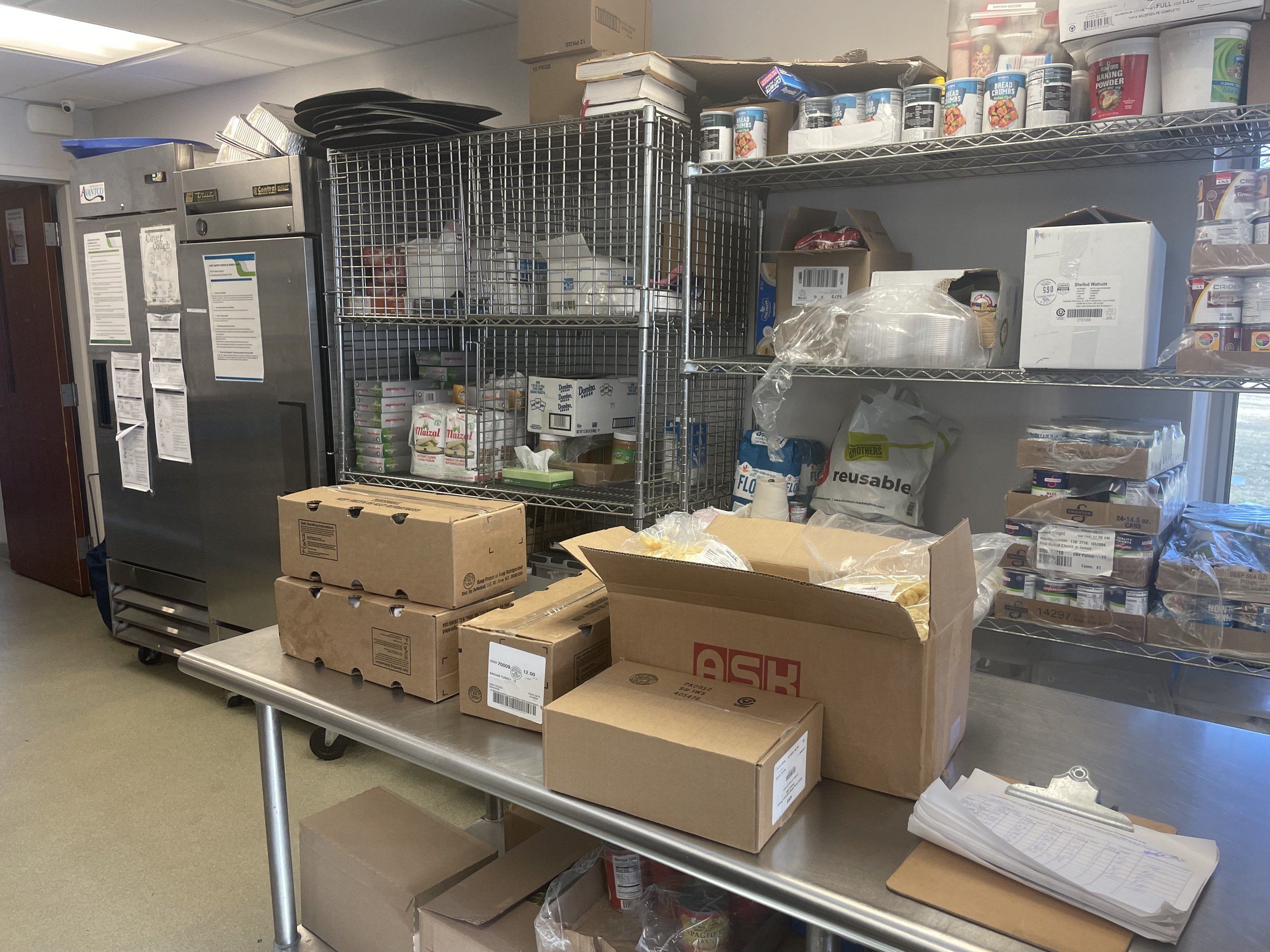
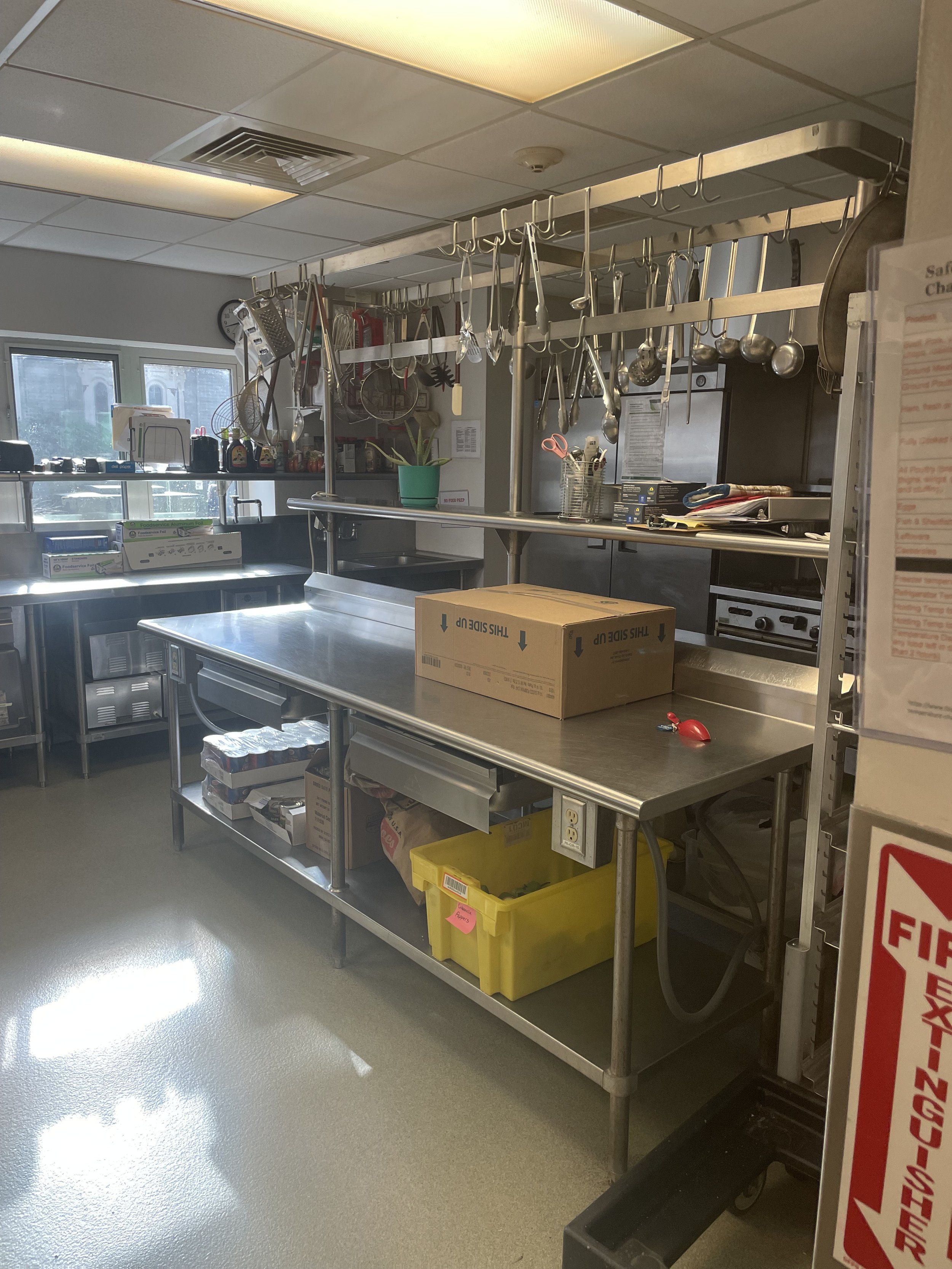

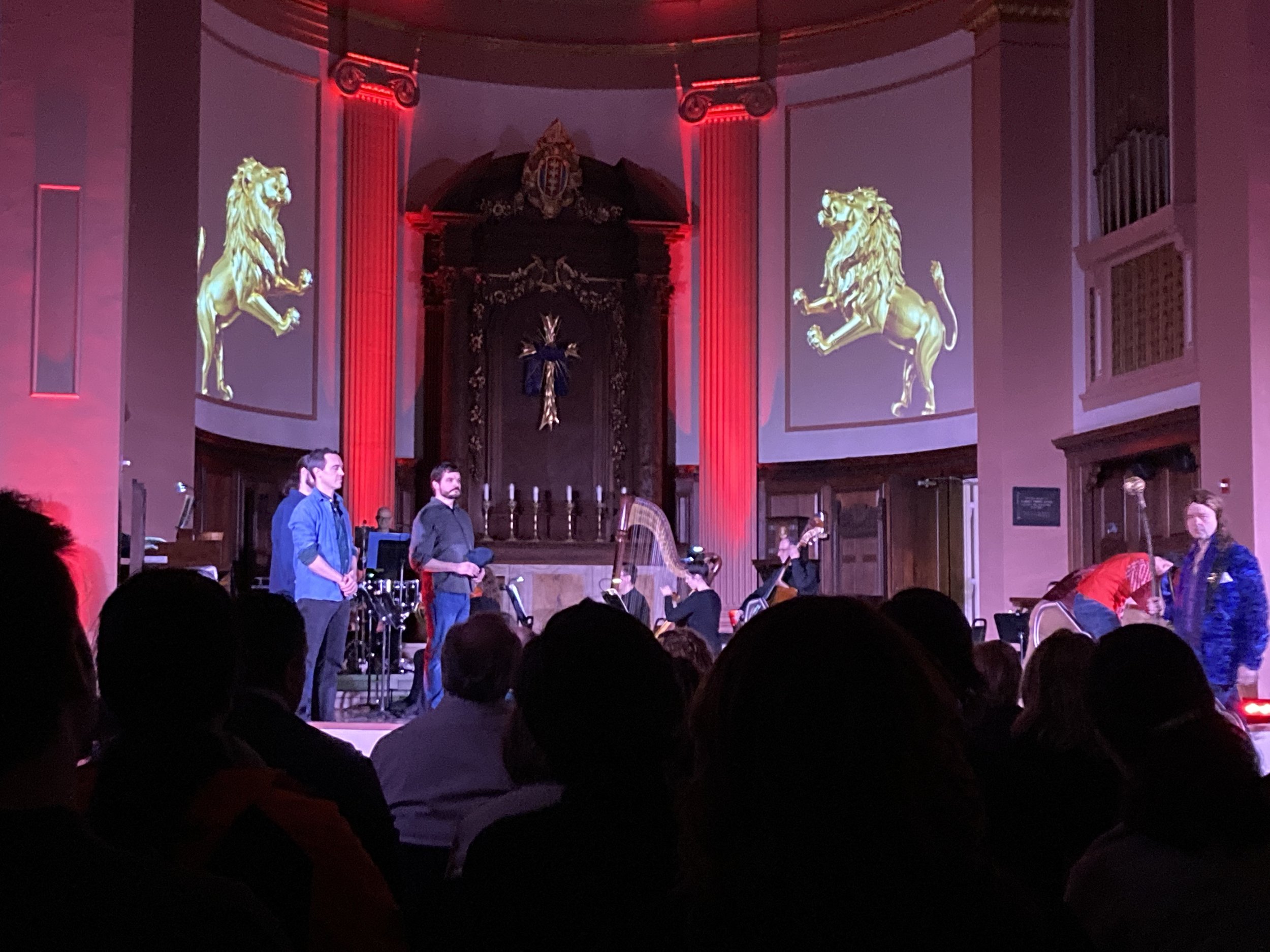
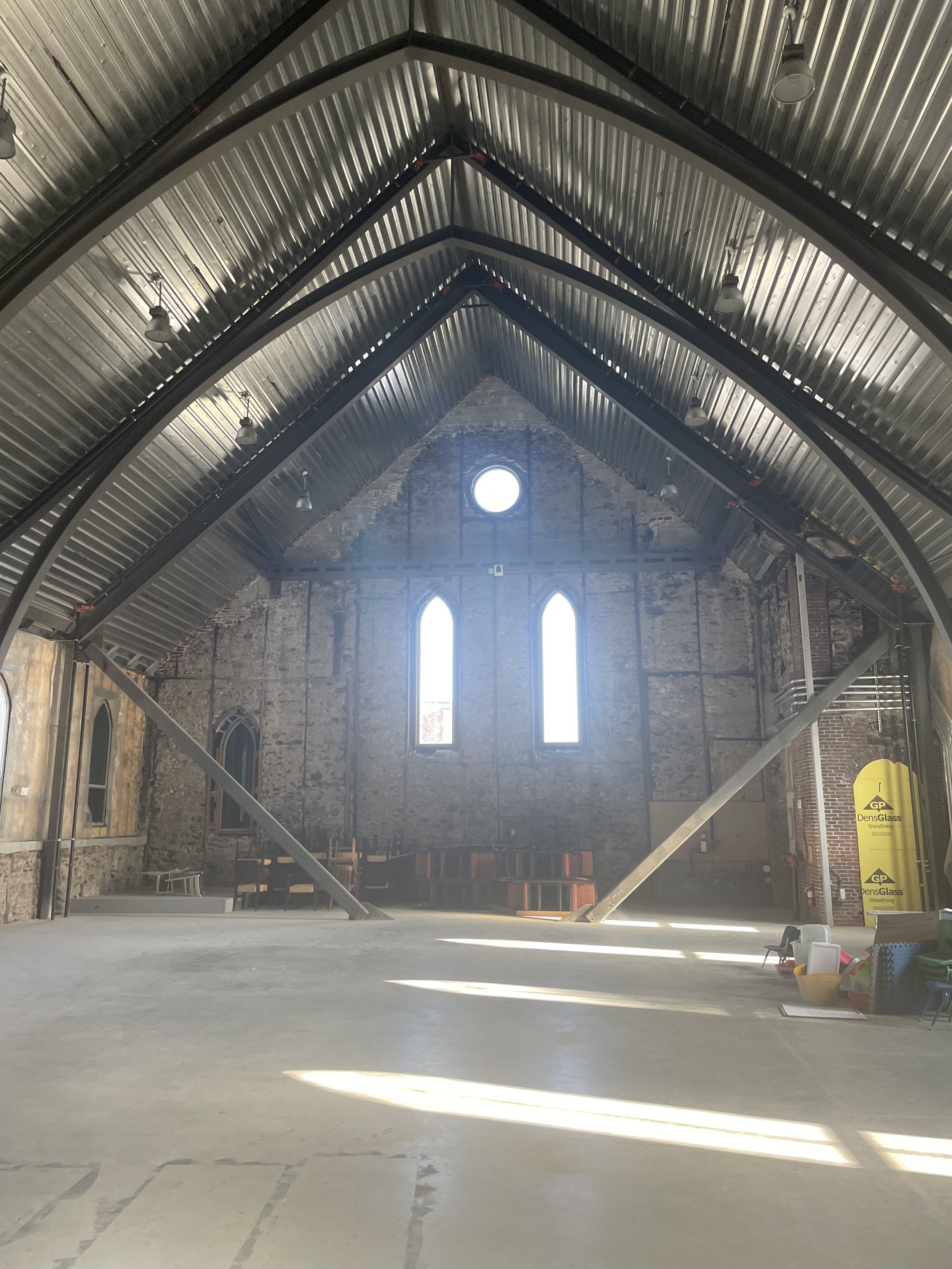







![The Value of Making Youth Voices Heard [VIDEO]](https://images.squarespace-cdn.com/content/v1/57ff1c7ae58c62d6f84ba841/1540908939188-LRJKMBIWZXOOO5V5A9UP/Screenshot+2018-10-30+10.08.13.png)

![Urban Youth Culture Research [Resource List]](https://images.squarespace-cdn.com/content/v1/57ff1c7ae58c62d6f84ba841/1530294363902-G2R6K4YMB3AX42HOIMH9/black-and-white-crowd-gang-38198.jpg)
![God Met Me in Boston [Interview]](https://images.squarespace-cdn.com/content/v1/57ff1c7ae58c62d6f84ba841/1529427271630-4CUDW0ICCL9D8IQ4SV4I/Ruth+%26+Cherchaela+2.jpg)

![[Video] 2018 Trends in Youth Culture](https://images.squarespace-cdn.com/content/v1/57ff1c7ae58c62d6f84ba841/1523474943655-9Q698S527EGBAHR9PLTX/action-adults-celebration-433452.jpg)












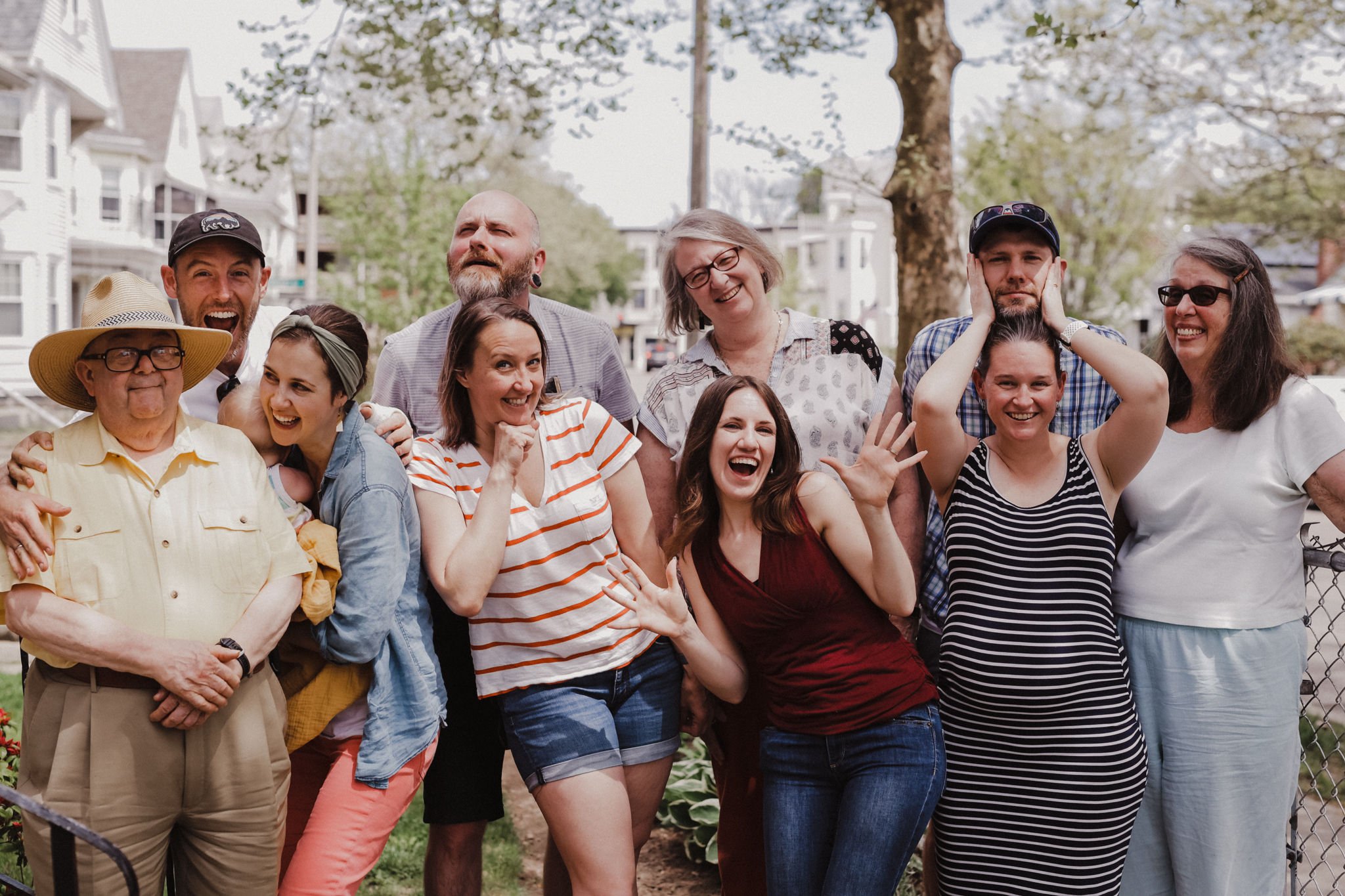











































![Gender Based Violence & the Church [Resources]](https://images.squarespace-cdn.com/content/v1/57ff1c7ae58c62d6f84ba841/1525202179581-91N8RV6OP4ASQAHLX1OD/black-and-white-black-and-white-depressed-568025.jpg)









![Christian Leadership Web Sites [Resource List]](https://images.squarespace-cdn.com/content/v1/57ff1c7ae58c62d6f84ba841/1505489399837-OVLHG7QQ7TJ6K8RIJBG7/pexels-photo-209151-website.jpeg)
![Biblical Theology Of Leadership [Resource List]](https://images.squarespace-cdn.com/content/v1/57ff1c7ae58c62d6f84ba841/1503082312592-NX21D7QBK2IYCYEPM32I/pexels-church_Theology.jpg)
![Inner Life Of A Leader [Resource List]](https://images.squarespace-cdn.com/content/v1/57ff1c7ae58c62d6f84ba841/1503082360379-C5ZBYKU7T85I40JH5WMS/pexels-inner-life-airballoon.jpg)

































![Hidden Treasures: Celebrating Refugee Stories [photojournal]](https://images.squarespace-cdn.com/content/v1/57ff1c7ae58c62d6f84ba841/1512579164575-AKNVCYX4Q5DW8IN2CNYP/P1070998.jpg)

![Connecting Multi-Site Church Leaders [PhotoJournal]](https://images.squarespace-cdn.com/content/v1/57ff1c7ae58c62d6f84ba841/1513116581077-WOWU94O437SJAKKAMZMA/DSC_0438-for-header.jpg)
























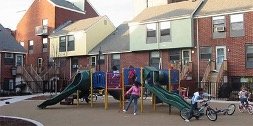















Since its founding, the BEC has helped make an impact on church-based programs in Greater Boston that help urban residents reach educational goals.